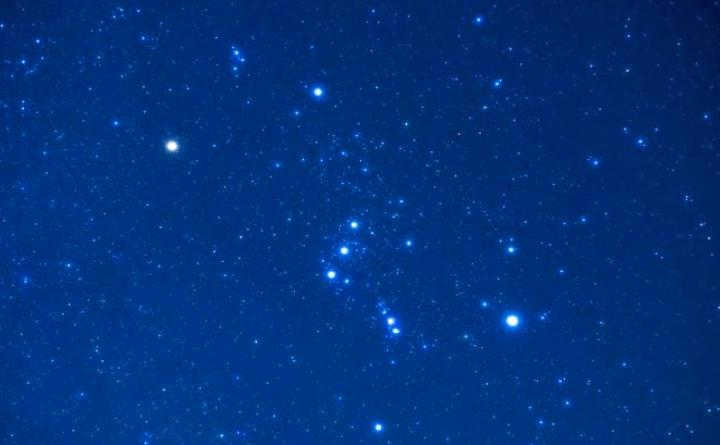
The constellation Orion contains a notable asterism known as Orion’s Belt. An asterism refers to a distinctive group of stars with a recognized name. Orion’s Belt consists of three blue-white stars that encircle the figure of the hunter, symbolizing the constellation. These stars are historically named Alnitak, Alnilam, and Mintaka.
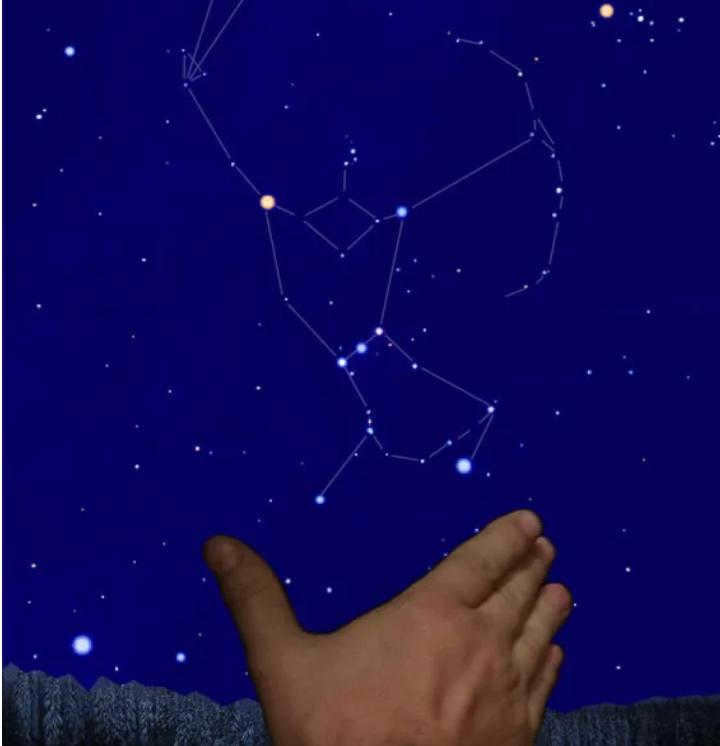
The translation of the constellation’s name from Arabic means “girdle”, “string of pearls”, “belt” respectively. Throughout history, different civilizations have seen the trio of stars as a mystical sign or symbol. In the Christian faith, it is connected to the Holy Trinity. Some interpretations suggest that the three stars serve as a reminder that a person is under the watchful eye of their guardian angel.
The Orion constellation
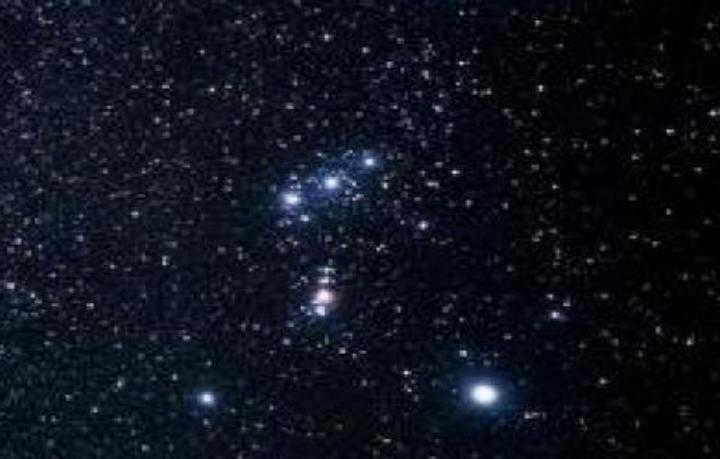
Orion is situated in the area of the celestial equator and stands out as one of the most easily recognizable constellations in the night sky. It takes its name from the legendary Greek hero Orion, a hunter known for his exceptional beauty and towering figure.
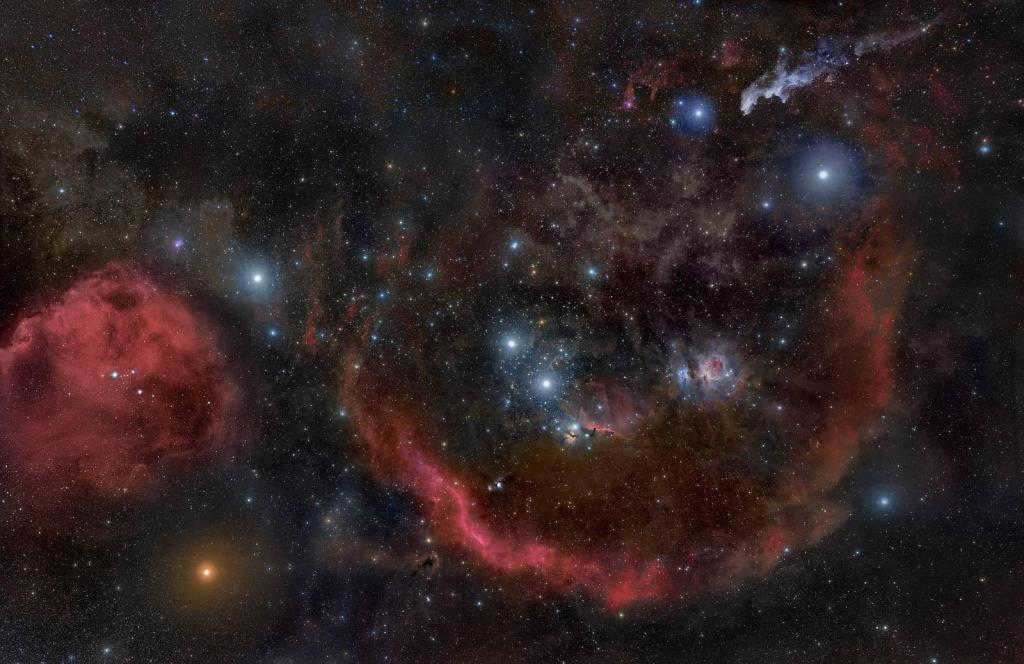
In accordance with one of the interpretations of the Orion legend, Gaia dispatched a scorpion to Artemis, by whom Orion was located, and the scorpion bit him. The hunter was then transported by Artemis to the celestial realm. Individuals can effortlessly locate the Orion constellation in the heavens due to the presence of three luminous stars, arranged in a linear fashion and separated by nearly equal angular distances.

The constellation Orion is positioned on the celestial equator, making it visible from both the northern and southern hemispheres. The group of stars known as Orion’s belt is most easily seen between the months of November and January. It is thought to bring good fortune to those who spot the three stars in a straight line, although there are various other interpretations as well.

When you spot a sequence of three stars, it signifies the need to adopt a more optimistic perspective on the world. Instead of seeing the glass as half empty, try seeing it as half full. Have faith that everything will work out. It’s important to focus on the positive aspects and seek out moments of positivity in any given situation. By doing so, you can recharge your energy and move forward confidently towards your intended destination.
Your guardian angel is watching over you

When three stars align, it could be a sign that your personal guardian angel is keeping a watchful eye on you, offering their protection. Even in the face of adversity, it’s important not to lose hope. Rather, view challenges as trials sent your way, knowing that divine assistance will guide you through.

The message conveyed by the three stars suggests that your personal success will be greatly influenced by your own actions. If you are discontent with your current circumstances, it is time to make a change. Consider relocating, pursuing a new career, or terminating a toxic relationship.
Assistance on your selected journey

Three celestial bodies in the firmament offer their encouragement to you in your daring undertakings. They signify that you possess an ample amount of life experience to depend on your own self. Have faith in yourself, your wisdom, talents, and capabilities, for they have assisted you on numerous occasions in overcoming challenging circumstances.
Attention to details is crucial

The final meaning linked to a sequence of three stars is the requirement to give consideration to even the tiniest particulars. For they may hold significant importance to you. It is essential to exercise caution and not disregard anything, as there could be adverse repercussions in the times ahead.
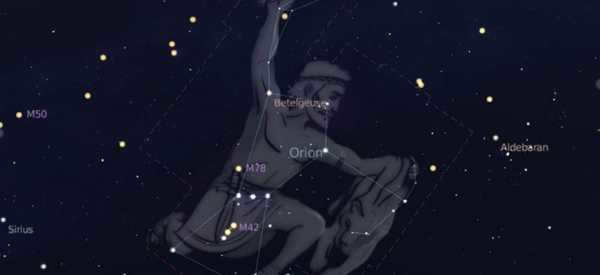
The Orion constellation is one of the most well-known and renowned constellations. It can easily be located on the celestial map, particularly during the autumn and winter seasons. In Russia, it is best observed from mid-August to mid-April. If you gaze up at the night sky, you will spot it in the southern region: three brilliant stars aligned in a straight line and equidistant from one another. This alignment is known as Orion’s belt, which is a defining feature of the Orion constellation.
The Legend of Orion: Unveiling the Mythology behind the Constellation
Ancient Greece was a treasure trove of captivating myths and legends. Among them, the tale of a remarkable hunter from Thebes has stood the test of time. Known for his unparalleled beauty and towering stature, this hunter was often referred to as a giant. His name? Orion. It is believed that the fabled constellation Orion is closely intertwined with the story of this mythical hunter.
The origin of Orion is a matter of great confusion. There are numerous accounts, but let’s focus on the primary one.
According to Greek mythology, Orion is the offspring of Poseidon, the god of the sea. Tales from ancient times depict a fascinating narrative where the gods roamed the earth in human form, performing incredible feats.
The story begins with Zeus, Hermes, and Poseidon, three prominent Greek deities, venturing into the city of Thebes. During their visit to a man named Giriye, they offered a bull as a sacrifice and indulged in its meat.
The gods paid close attention to his words and requested that he retrieve the hide of the bull. After carefully listening to his pleas, the gods asked him to obtain the skin from the bull, which had been offered as a sacrifice and accepted by the gods. They proceeded to fill the bull’s skin with urine and instructed him to bury it. Several months later, Orion was born, supposedly as a result of this ritual. Legend has it that Orion was bestowed with the ability to walk on water by his father Poseidon.
Orion’s tale
Orion, a magnificent and courageous hunter, possessed remarkable strength. Accompanying him on his adventures were two loyal canines, known as Big Dog and Little Dog.
Life continued its ordinary course, until Orion made the decision to embark on a journey of matrimony. It was then that he laid eyes upon Merope, a woman who captivated his heart. However, her father, Oenopion, had a condition. Orion had to rid the island of Chios from its menacing predators. Without hesitation, the hunter fulfilled his duty, but Oenopion continuously postponed the wedding, failing to uphold his end of the bargain. Driven by love and frustration, Orion resorted to abducting Merope against her father’s wishes. The consequences were dire, as Oenopion retaliated by rendering the hunter blind.
With the assistance of his companion Kedalion, the blind hunter Orion embarked on a journey to the location where the sun god Helios emerges. Placing his eyes beneath the radiant beams of Helios, Orion’s vision was restored. However, as the saying goes, every cloud has a silver lining, for it was there that he fell deeply in love with Eos, the goddess of the dawn, and they became passionate lovers.
Orion accomplished numerous feats in Sicily, constructing a seawall and establishing a harbor. Subsequently, he chose to reside on the island of Euboea.
The death of Orion is shrouded in enigma and fables, with such a multitude that one could compose an entire article without uncovering the truth.
With so many people, there are just as many diverse myths, yet many individuals recount the same tale.
Orion was stung by a scorpion, resulting in his demise. However, opinions diverge at this point. There are several theories as to who dispatched this scorpion to commit such a heinous act. One version suggests that Gaea or Poseidon sent the scorpion.
According to another interpretation, Gaia intended to send a scorpion to bite Artemis, but the scorpion made a mistake and bit Orion instead.
Orion is such a captivating constellation with such an extraordinary legend.
According to myth, Orion left behind two daughters and 50 sons.
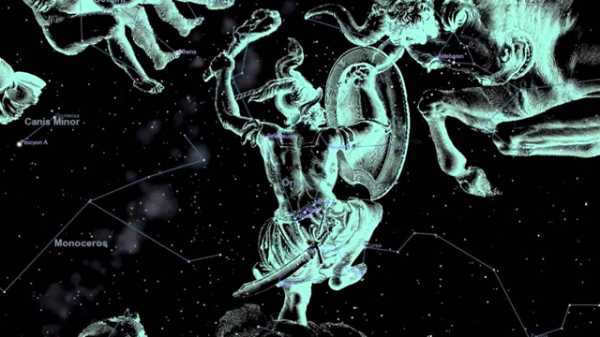
The constellation of Orion is known for its stunning beauty and remarkable appearance. So what does Orion’s constellation look like?
Descriptions
Orion’s constellation consists of 209 stars that are easily visible to the naked eye. These stars form the shape of a hunter holding a sword and shield.
Among the stars in the constellation, three stars stand out the most. These blue-white stars are located close to each other and form a straight line. They are often referred to as Orion’s Belt. Additionally, these three stars are also known as the Three Kings or the Three Magi.
Incidentally, the constellation of Orion and the star Sirius are situated in close proximity to one another within the constellation of Canis Major, and one can readily distinguish the most luminous star in Orion. Or more specifically, by mentally connecting three brilliant stars, one can trace a line towards the southeast and locate a prominent star. Rest assured, Sirius is unmistakable and cannot be mistaken for any other celestial body.
The constellation of Orion boasts an abundance of brilliant and exquisite stars. Let us now examine the most radiant and renowned stars within the constellation of Orion.
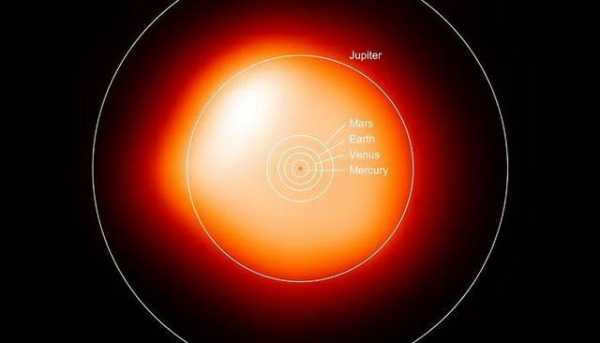

If Betelgeuse were to replace the Sun, it would completely occupy the orbit of Jupiter.
Stars within the constellation
The constellation of Orion contains a blue-white star named Rigel, which translates to “foot” in English. This star holds a unique position among the bright stars of the constellation, creating the appearance of an hourglass. Rigel can be found in the lower right-hand corner when observing the constellation as a whole. In terms of the hunter Orion, Rigel represents the left leg, specifically the heel.
Rigel is notable for its large size and brightness. It is situated approximately 800 light years away from the Sun and is 75 times larger and 130,000 times more luminous than the Sun. This makes Rigel the closest star to us with such a brilliant luminosity. The star held significant importance to the ancient Egyptians, who revered it and associated it with Osiris, the god of the afterlife.
The red giant star Betelgeuse
Betelgeuse, situated in the constellation Orion, is a remarkable celestial body. Its name, Betelgeuse, translates to “hand” in Arabic.
Located in the upper left region of the hourglass-like Orion constellation, Betelgeuse serves as the right shoulder of the mythical hunter.
The luminosity of Betelgeuse is constantly fluctuating, making it a variable star. At its minimum, Betelgeuse’s luminosity is 80,000 times greater than that of the Sun, while at its maximum, it reaches a staggering 105,000 times.
Not only is Betelgeuse luminous, but it is also impressively large. If we were to replace our Sun with Betelgeuse, it would extend beyond the orbit of Jupiter at its largest size. To put this in perspective, Jupiter is the fifth planet from the Sun in our solar system.
Betelgeuse boasts a mass 15 times greater than that of the Sun and is located approximately 550 light years away from us.
Observing Bellatrix is a fascinating experience due to its status as a variable red giant. Its future holds the possibility of either a supernova event or the shedding of its outer layers to become a white dwarf. The exact timing of this transformation remains unknown, but when it does occur, it promises to be a truly spectacular sight.
The Star Bellatrix
Bellatrix, also known by various names such as Amazon, conqueror, warrior, and lion’s roar, is a blue-white giant located in the Orion constellation. Positioned in the top right of the hourglass shape, this star can be found near the bicep of the hunter’s left arm.
Ranking as the 26th brightest star, Bellatrix was utilized for navigation purposes in ancient times, further highlighting its historical significance.
Bellatrix shines 4,000 times brighter than the Sun and is 6 times larger and 10 times more massive. This star is quite sizable, but it is also incredibly young, only about 20 million years old. Despite its youth, Bellatrix consumes its fuel rapidly, and within a few million years, it will transform into either a red giant, a supernova, or a white dwarf.
The celestial body known as Alnilam is a brilliant blue supergiant situated in the constellation Orion. Alnilam, which is derived from the Arabic word for “thread of pearls,” can be found at the center of the three prominent stars comprising the hunter’s belt. Notably, Alnilam ranks as the 30th brightest star in the Orion constellation, making it one of the 58 stars historically utilized by sailors for navigation purposes.
Alnilam boasts an estimated age ranging from 4 to 106 million years. In the coming future, approximately one million years from now, this celestial entity is projected to undergo a dramatic transformation, transitioning into either a red giant, a supernova, or a white dwarf.
The celestial object Alnitak
Alnitak is a remarkable celestial object located in the constellation of Orion. It is a triple star system situated at the upper part of Orion’s belt. Alnitak consists of three stars – the dominant member being the blue supergiant Alnitak A, along with two smaller blue stars. Alnitak A is an enormous star, boasting a size that is 20 times larger than our Sun.
The celestial body Saif
Saif is located southeast of Orion’s belt, resembling the knee of the hunter in the night sky. It is an intriguing star to observe, characterized by its blue-white appearance. Saif is a massive star, being 22 times larger than the Sun. Its luminosity outshines our Sun by an impressive 57,500 times.
The Mintaka star
Mintaka, a blue supergiant star, is situated on the far right of Orion’s belt. It is a multiple star, with two or more stars in its system. While not visible to the naked eye, when observed through a telescope, you can see two or three stars simultaneously. It is an intriguing celestial object to study.
Asterisms
What are Asterisms? They are a collection of stars that are easily identifiable and have their own unique names.
We have previously mentioned the Sheaf or Butterfly asterism, which also resembles an hourglass.
Orion’s Belt is a well-known asterism, also referred to as the Three Kings or the Three Magi.
The Sword of Orion is an asterism that hangs from the hunter’s belt, consisting of two stars and a nebula.
Orion’s Shield is another notable asterism, composed of six stars.
Orion’s Club is held in the hunter’s right hand and contains five stars.
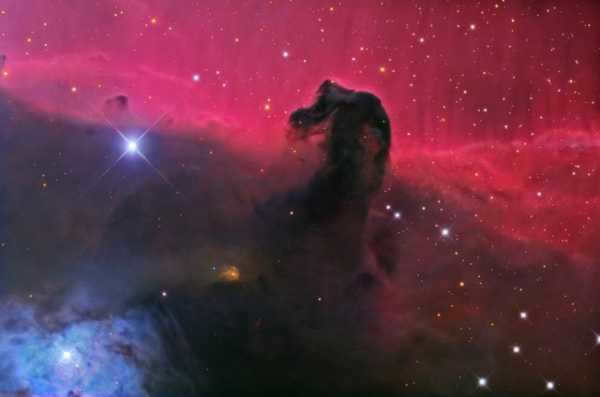
The Horsehead Nebula is a well-known celestial object located in the constellation Orion. It is one of the many nebulae and star clusters that can be found in this region of the sky. This particular nebula, also known as IC 434, is situated near Orion’s belt, specifically next to the leftmost star, Alnitak A.
The Horsehead Nebula is a dark and distinctive formation that resembles the head of a horse against a backdrop of red hues. It is a captivating sight and is often admired by stargazers and astronomers alike.
Another fascinating nebula in the Orion constellation is M43, also known as de Merana or NGC 1982. This emission nebula is a hub of active star formation, exhibiting a vibrant display of cosmic processes.
When exploring the constellation Orion, one will find the M43 nebula situated near the hunter’s sword, resembling a comma in shape. It is a renowned celestial object, particularly revered during the winter months in Russia.
The Orion constellation is a treasure trove of celestial wonders, offering a plethora of nebulae, star clusters, and other intriguing phenomena. It is an exciting area of the night sky to explore and observe.
Orion Cloud
The Orion cloud is worthy of particular interest. This is an exceedingly expansive region, with an immense expanse spanning several hundred light years.
Encompassed within the Orion cloud are numerous distinct entities – M42, M43, M78, the Horsehead Nebula, Barnard’s Loop, NGC 2024 (Flame Nebula), NGC 1973, NGC 1975, and NGC 1977. It is a remarkable subject for observation.
How to locate the Orion constellation
As mentioned earlier, the optimal time for observing the Orion constellation in Russia is during the autumn and winter seasons. The visibility of the constellation varies depending on the location and month of observation. The months of November through January offer the best opportunities to view Orion. In November, Orion rises in the late evening.
When looking up at the night sky, you will have no trouble spotting this well-known constellation. Its distinctive feature is a sequence of three bright stars, known as Orion’s belt, arranged in a line. These stars are easily recognizable.
Positioned at the top left of the belt is the red star Betelgeuse, while the bottom right is occupied by the white star Rigel. Orion’s belt lies in the middle. Take the time to locate this constellation and appreciate its beauty.
Mysteries surrounding the Orion constellation
The Orion constellation holds many enigmatic secrets. What makes it even more intriguing is the fact that its shape closely mirrors the outline of the Kola Peninsula and the coastline of the White Sea. Remarkably, the Kola Peninsula is adorned with man-made labyrinths and sanctuaries that align with the constellation.
One fascinating legend tied to this celestial formation is that of the Hyperboreans. According to ancient Greek mythology, Hyperborea, a land steeped in the traditions of ancient civilizations, is said to exist somewhere in the northern regions.
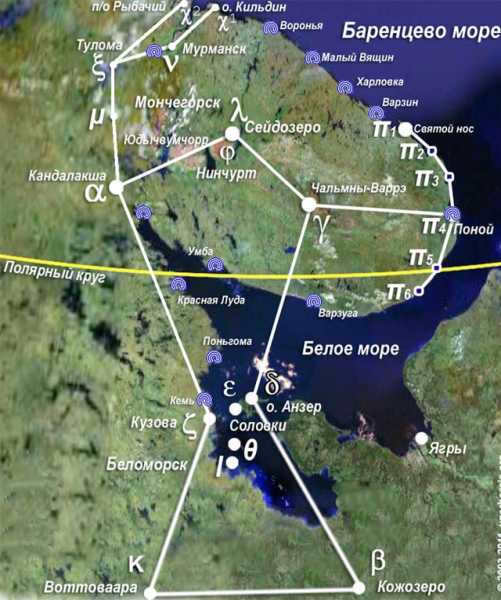
The Murmansk region is home to the famous constellation Orion, according to Greek mythology. The Hyperboreans, who are said to be the descendants of the ancient Titans, were believed to have been visited by Apollo himself in his chariot.
In 2005, a team of international scientists conducted extensive research in the northern region of Russia, uncovering fascinating discoveries. If you’re interested, you can read more about it. The findings are quite intriguing, and it’s up to you to decide whether to believe them or not. Nonetheless, the evidence presented is quite compelling.
Observe the captivating and awe-inspiring Orion constellation as it illuminates the night sky. Don’t miss the opportunity to explore the enigmatic Big Dog constellation, which is also filled with countless wonders.
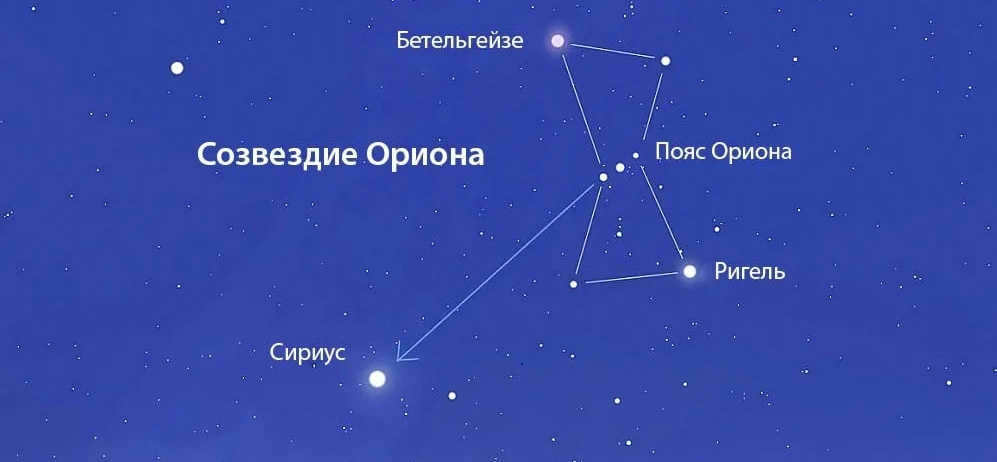
The constellation Orion is known for its stunning beauty and is easily recognizable. But what exactly does Orion look like?
With a total of 209 stars that can be seen without the aid of a telescope, this constellation forms the shape of a mighty hunter holding a sword and shield.
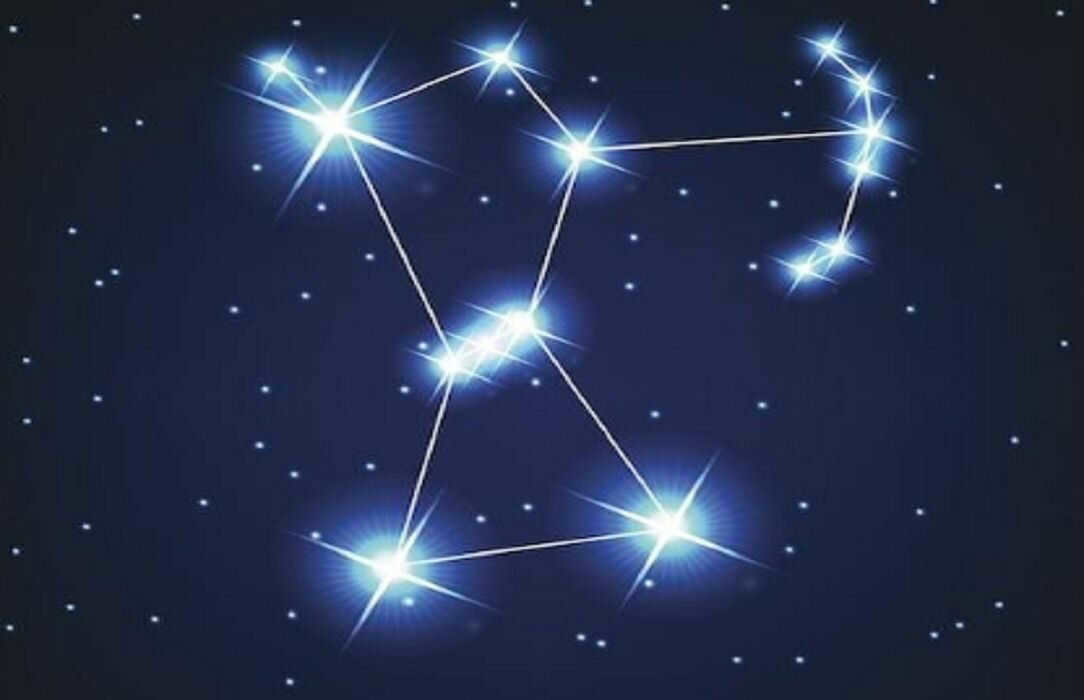
The three stars in the constellation are the most well-known. They are blue-white stars and are positioned close to each other in a nearly straight line. They are also referred to as Orion’s Belt. These stars have been given the names of the three kings, the three wise men (magi).
Interestingly, the constellation Orion and the star Sirius are located adjacent to each other in the constellation of the Great Ogre, and Orion can easily be recognized as the brightest star. Specifically, by mentally connecting the three brightest stars and drawing a line towards the southeast, the brightest star can be seen. Trust me, Sirius is unmistakable.
The Orion constellation is abundant in bright and stunning stars. Let’s explore the most brilliant and renowned stars of the Orion constellation.
Legend of Orion: A Mythological Tale
Ancient Greece was steeped in captivating myths and legends. Among them, the tale of Orion, a renowned hunter hailing from Thebes, stands out. This majestic figure possessed unparalleled beauty, towering over others with his colossal height. His immense stature earned him the moniker of a giant, thus giving birth to the constellation Orion.
The emergence of Orion
The origin or emergence of Orion is quite perplexing. Multiple accounts exist, but we will focus on the primary one.
According to myths, Orion is believed to be the son of Poseidon, the god of the sea. Legends narrate that in ancient times, when the Greek gods roamed the earth in human form and performed extraordinary feats, this fascinating tale unfolded.
The story commences with the three ancient Greek deities Zeus, Hermes, and Poseidon venturing into the city of Thebes. They paid a visit to a certain individual named Giridja, sacrificed a bull, and indulged in a feast.
Giridja appeased the gods with a feast and voiced her sorrow over her inability to conceive. The gods, lending a sympathetic ear, instructed her to procure the hide of a bull, which they graciously accepted as a tribute. They proceeded to fill the bull’s hide with urine and instructed Giridja to bury it. In due time, Orion was born. Legend has it that Orion inherited his father Poseidon’s extraordinary ability to walk on water.
Orion, a brave and mighty hunter, was accompanied by his two loyal canine companions, Big Dog and Little Dog.
Orion made the decision to enter into matrimony and his heart was captivated by the enchanting Merope. Oenopion, the father of Merope, proposed a condition to Orion. In order to proceed with the wedding, Orion was required to rid the island of Chios of its menacing wild beasts. The skilled hunter diligently fulfilled his end of the agreement, yet Oenopion continuously postponed the nuptials. Frustrated by the delay, Orion resorted to kidnapping Merope, forcibly taking her as his bride. This act provoked a furious response from Merope’s father, who retaliated by blinding the hunter.
Now sightless, Orion sought the assistance of his loyal companion Kedalion to guide him to the location where the radiant sun god, Helios, would rise. Placing his eyes beneath the warm rays of Helios, Orion’s vision was miraculously restored. However, as the saying goes, every silver lining has a cloud: it was at this moment that Orion became enamored with Eos, the goddess of dawn, and they embarked on a passionate love affair.
While in Sicily, Orion undertook extensive construction projects, including the construction of ramparts and a harbor. Despite his achievements, he chose to continue living in Euboea.
The Mysterious Death
Orion’s demise is surrounded by a multitude of myths and legends, so much so that an entire article could be dedicated to uncovering the truth.
Various nations have their own unique tales, yet many share a common narrative.
The prevailing story suggests that Orion was fatally stung by a scorpion. However, opinions diverge when it comes to who orchestrated this heinous act. One version suggests that the scorpion was sent by Gaea or Poseidon.
Another version posits that Gaia initially intended for the scorpion to sting Artemis, but it mistakenly targeted Orion instead.
Constellation Location in the Sky
The constellation of Orion can be easily seen in the night sky between November and February. It is situated in the northern hemisphere and is most visible between latitudes 85º and -75º.
Orion’s belt, composed of the stars Alnilam (ε of Orion), Mintaka (δ of Orion), and Alnitak (ζ of Orion), is the most prominent feature in the constellation. Betelgeuse, the second brightest star in Orion, marks the right arm of the hunter, while Bellatrix serves as Orion’s left arm.
The central “star” in Orion’s sword, which hangs from Orion’s Belt, is the Orion Nebula. It is not a star but a formation of dust, hydrogen, helium, and other ionized gases. Rigel, the brightest star in Orion, forms the hunter’s left knee.
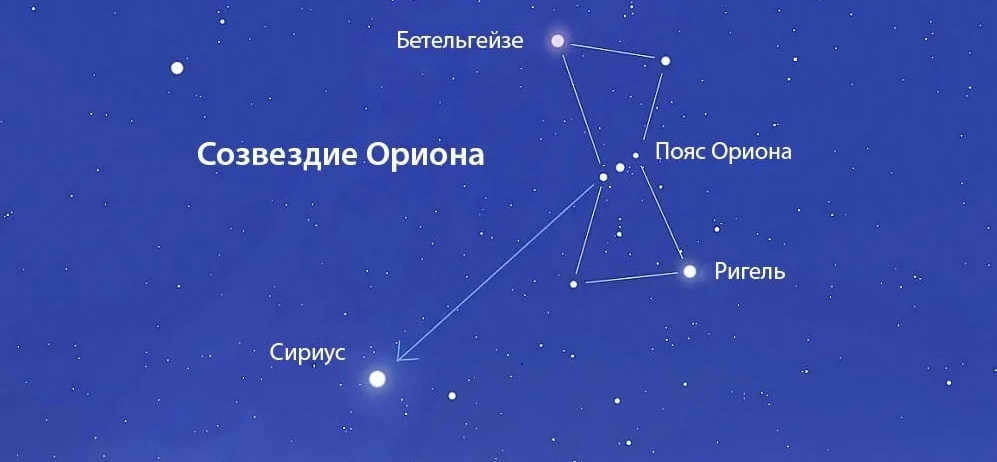
Stars within the Orion Constellation
Rigel: The Brightest Star in Orion
Rigel is the most luminous star in the Orion constellation. With an apparent magnitude of 0.18, it ranks as the sixth brightest star in the entire night sky. Despite not being designated as “alpha,” Rigel consistently outshines Betelgeuse. Rigel is a trinary star system, composed of three individual stars. Its existence was first documented by Struve in 1831. The star is enveloped by a gaseous atmosphere.
Rigel is classified as a blue supergiant, belonging to the B8lab spectral type. Located approximately 772.51 light-years away from our solar system, Rigel is 85,000 times more luminous and 17 times more massive than our Sun.
Rigel has been developing for approximately 10 million years. In due course, it will transform into a red supergiant.
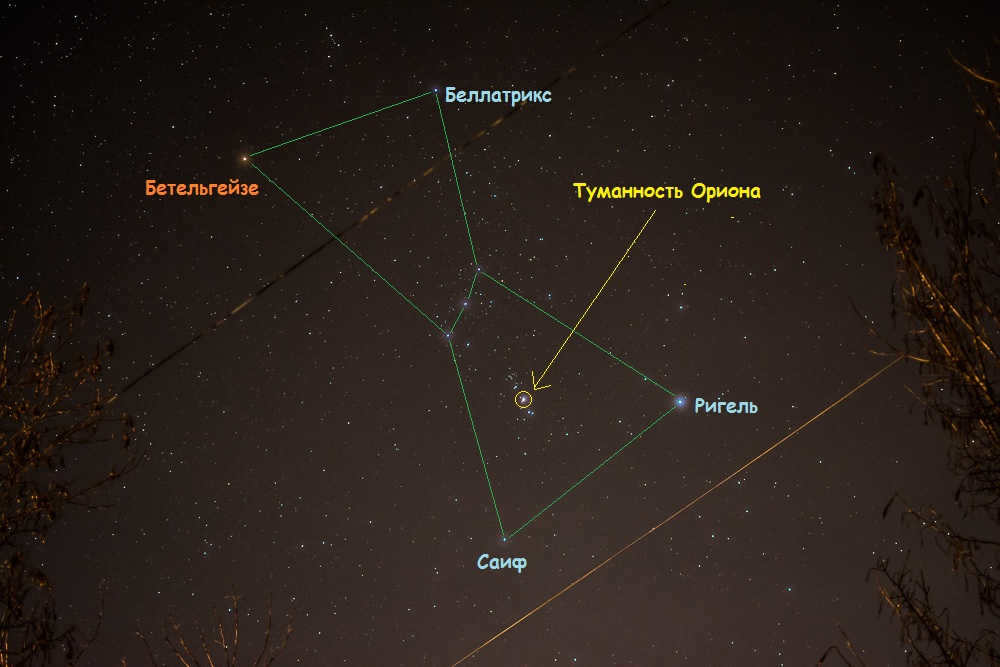
Betelgeuse is the alpha star in the constellation of Orion.
Betelgeuse, located in the Orion constellation, is the second most luminous star in the sky. It is a red supergiant of spectral class M2lab. While not as bright as other supergiants like Deneb in the Swan constellation, recent research has shown that Betelgeuse emits more light than 100,000 suns, making it brighter than most stars in its class.
With an apparent magnitude of 0.42, Betelgeuse is located 643 light years away from Earth.
Bellatrix is the twenty-seventh most luminous star in the sky and the third most luminous star in the constellation of Orion. It derives its name from an Arabic term that means “female warrior”. With an average apparent magnitude of 1.64, Bellatrix is situated approximately 240 light-years away from our planet.
Bellatrix is classified as a hot, bluish-white giant star. It stands out as one of the most brilliant stars that can be observed without the aid of a telescope. It outshines the Sun by a factor of 6,400 and possesses a mass that is equivalent to nine solar masses. Over the course of a few million years, Bellatrix will undergo a transformation into an orange giant before eventually evolving into a white dwarf.
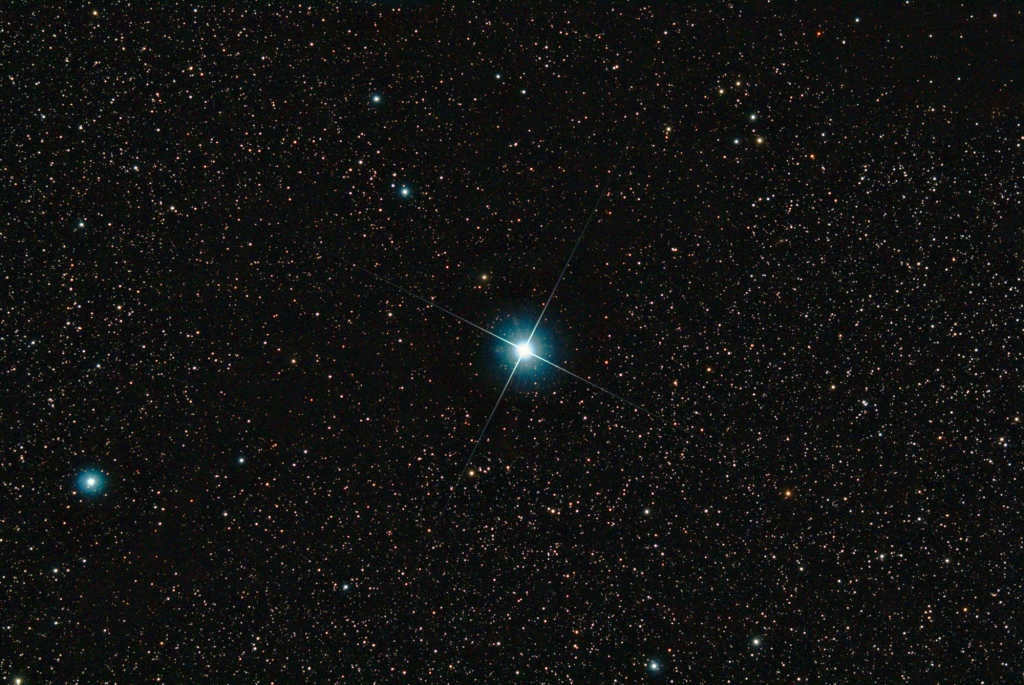
The constellation Orion has the star Mintaka as its δ
Mintaka is a binary star system composed of a giant B-class star and a hot O-class star that revolve around each other every 5.63 days.
Mintaka is situated approximately 900 light-years from Earth and has a mass over 20 times that of the Sun.
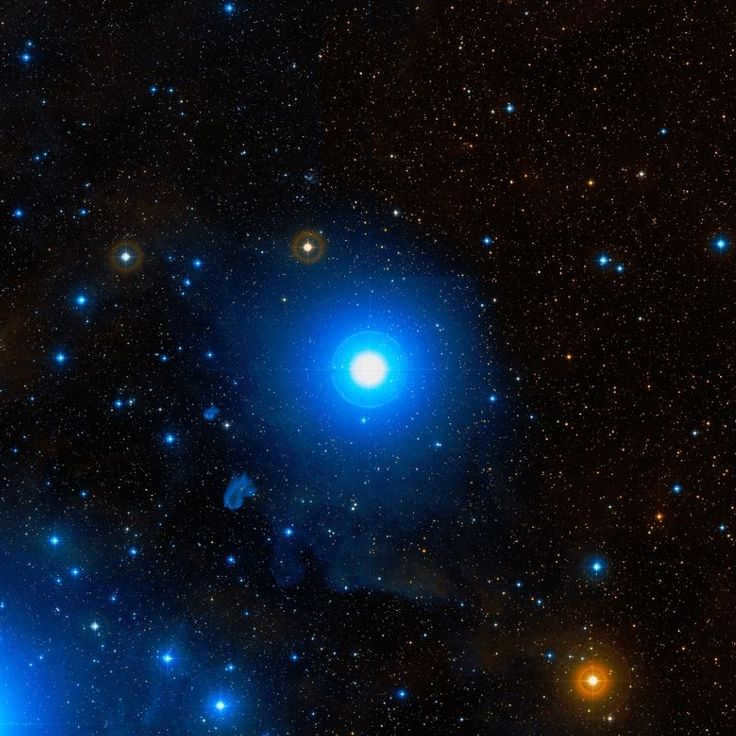
Orion’s Epsilon: The Location of Alnilam
Alnilam, also known as Orion’s Epsilon, is a blue supergiant star located approximately 1,400 light years away. It is 24 times larger than the Sun and shines more than 250,000 times brighter.
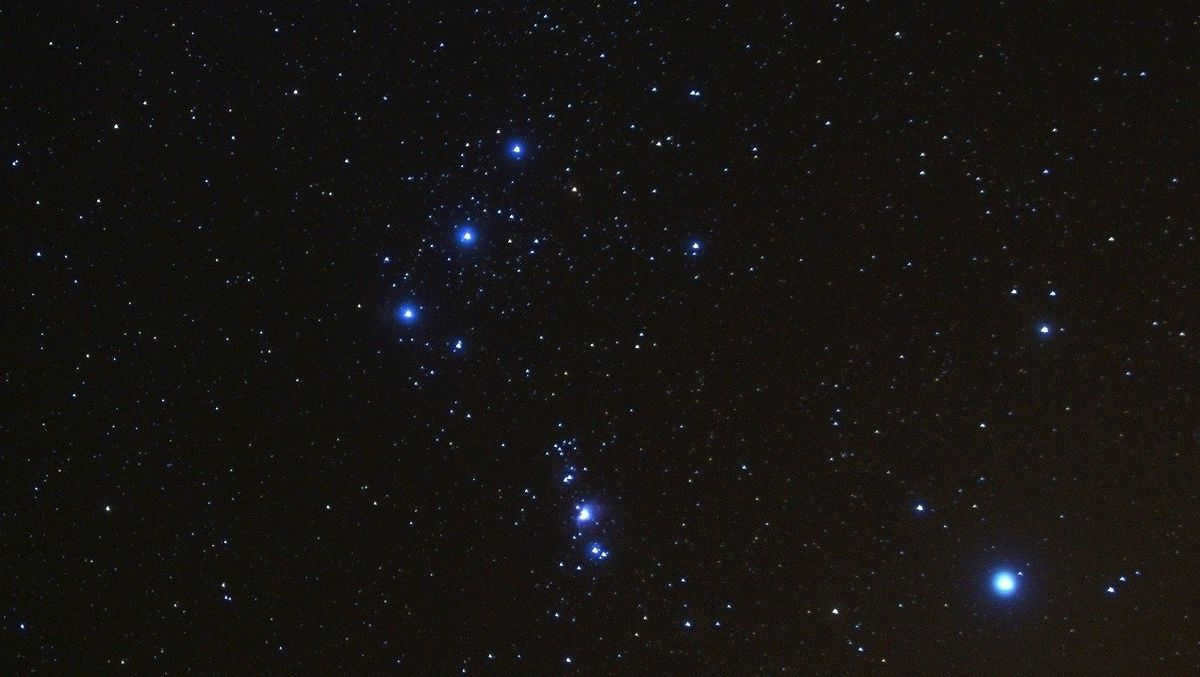
Orion’s ζ is represented by the star Alnitak
The star system Alnitak consists of three components and is located 736 light-years away from Earth. The main star, also known as Orion’s Zetta, is a blue supergiant with a radius approximately 20 times that of the Sun.
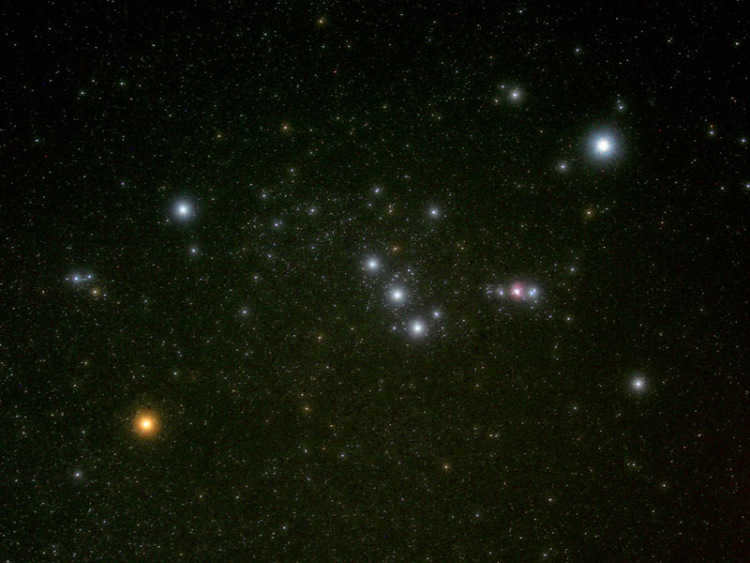
Exoplanets in the Orion Constellation
The Orion Constellation, also known as the Hunter, has proven to be a rich hunting ground for exoplanets. Below are some of the planets (or potential planets) that have been discovered in stars within the boundaries of Orion.
Located 1,200 light-years away, the star CVSO 30 is believed to have several potential planets. In 2012, a powerful telescope in Chile captured a direct image of a potential exoplanet, CVSO 30c. This gas giant orbits its star at a distance of 660 AU and completes its orbit every 27,000 years. In contrast, the second planet, CVSO 30b, is a gas giant located incredibly close to its star, only 0.008 AU away.
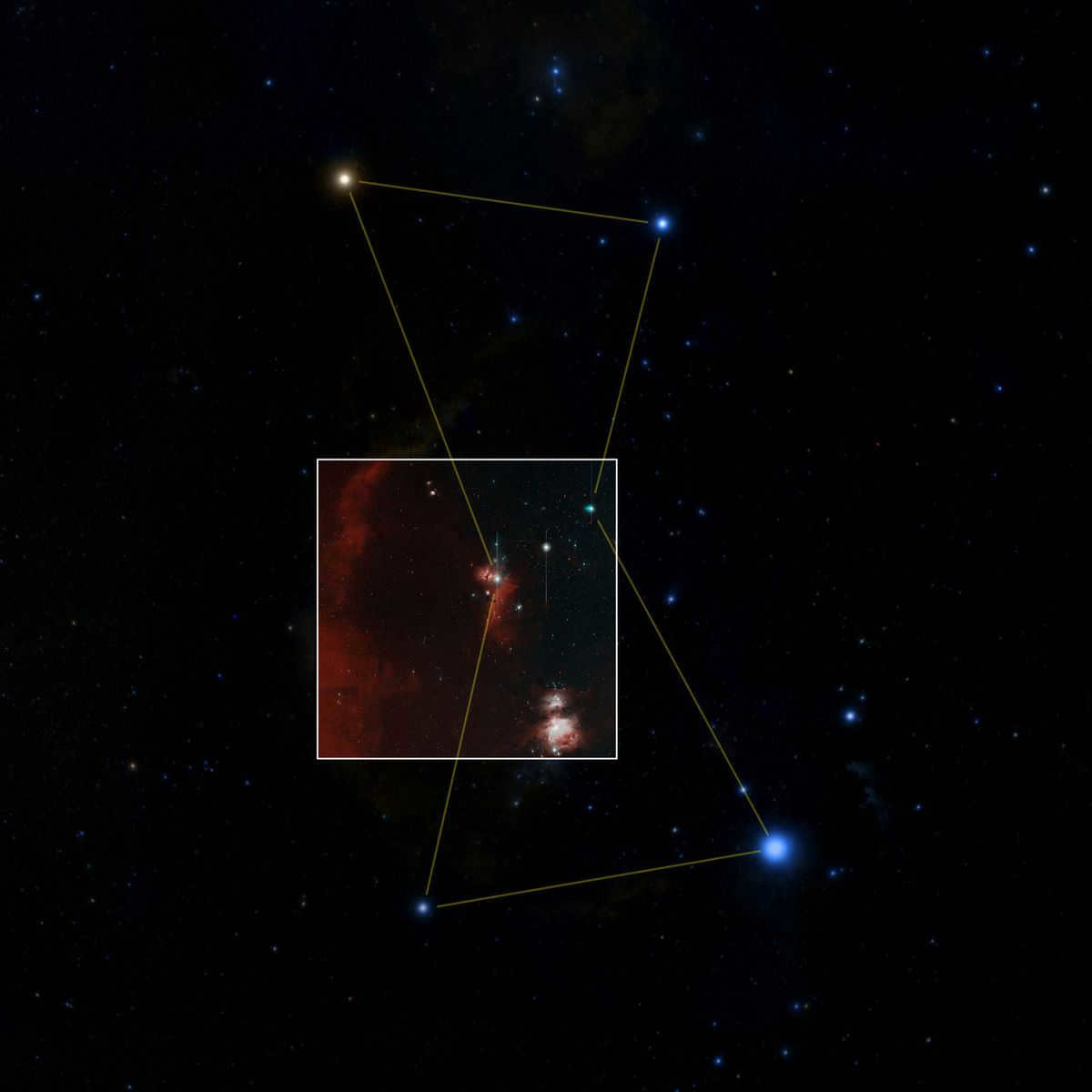
PTFO8-8695b, a potential exoplanet the size of Jupiter, is located approximately 1,100 light-years away from Earth. It is situated so close to its star that its outer layers are being stripped away. Scientists have observed high-energy hydrogen emissions in this star system that cannot be explained by the star’s activity or characteristics.
There are several other planets believed to exist in the Orion constellation, although their presence has yet to be confirmed through further observations. These planets include HD 38529 b and HD 38529 c, which are two gas giants orbiting a star with a large debris disk. There is also HD 38858 b, a gas giant located in the habitable zone of its star, and HD 37605 b, a gas giant in a very close orbit around its parent star.
Asterisms
It is important to mention that these are not the only objects, but rather the most significant, popular, and somewhat studied ones. It appears that not only individual stars, but also groups of celestial bodies make up the Orion constellation.
Furthermore, there is another well-known asterism called the Sword of Orion in the cosmic storyline. It appears to be composed of only three elements: 42 Orion, Theta, and Iota. Currently, Iota is located at the very tip of the sword. This particular component is known as Nair al-Saif or Hatsiyyah. Interestingly, Nair Al Saif constitutes a complete system of luminaries, or more precisely, a double spectral system. The primary component of this system is a blue giant of spectral type O9III, while the second component is a blue-white star B1.
Nebulae in the Orion Constellation
The Orion Constellation is home to a variety of nebulae that make up the Orion Cloud. These nebulae are located at a distance of approximately 1500-1600 light years and some can even be observed without the aid of a telescope.
M42: The Great Orion Nebula
Just below Orion’s belt, you can spot a hazy group of stars with the naked eye. This is the famous Orion Nebula, also known as M42. While its images are equally popular as those of the Andromeda Nebula, their compositions differ significantly. The Andromeda Nebula is a galaxy consisting of billions of stars, whereas the Orion Nebula is a cluster of gas, primarily hydrogen, situated within our own Milky Way galaxy and illuminated by nearby stars. It is one of the must-see objects in the winter sky for any astronomy enthusiast, who will undoubtedly aim their telescope or binoculars towards it.
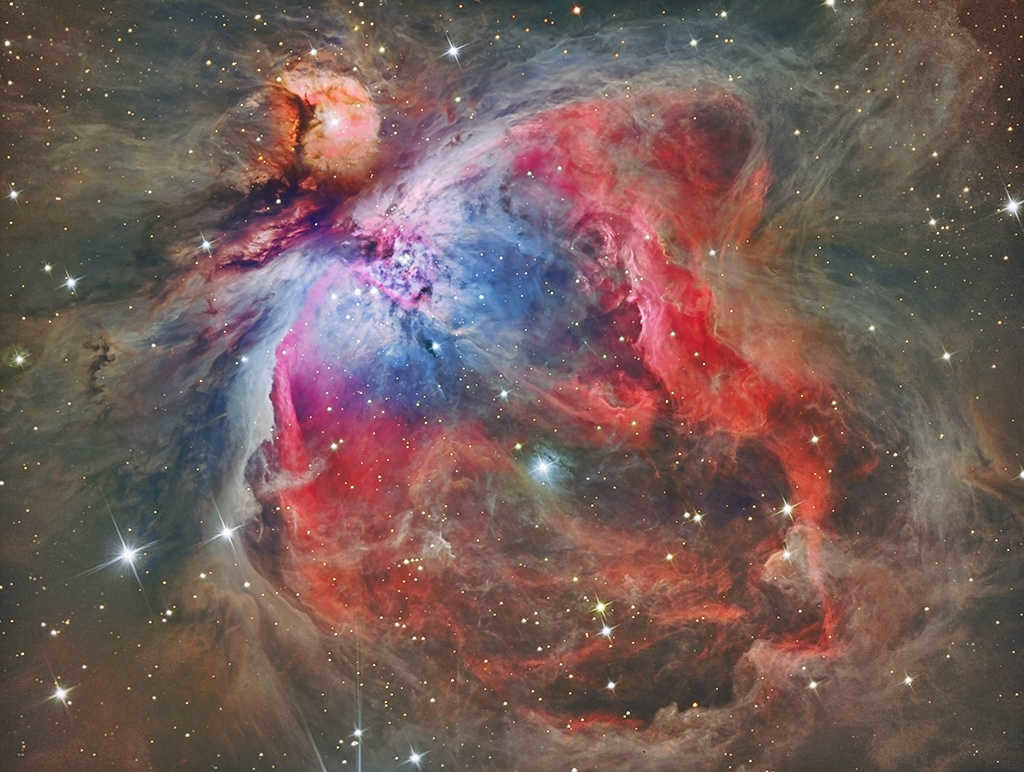
The Orion Nebula is located in the sky and covers an area four times the size of the full Moon. However, it is not visible to the naked eye. Situated at a distance of 1,344 light-years, the Orion Nebula has a diameter of 33 light-years.
Despite its apparent density, the gas in the Orion Nebula is incredibly dilute. To put it into perspective, one milligram of gas would weigh as much as 100 cubic kilometers of the nebula. In comparison, the best vacuum created in a laboratory is millions of times denser than the nebula. Nevertheless, the vast size of the nebula is evident, as all its hydrogen combined could form a thousand stars similar to the Sun or 300 million Earth-sized planets!
The Orion Nebula emits light due to the luminescence effect caused by stars that are either within or near the nebula.
The De Meran Nebula was initially observed by Jean-Jacques de Meran, a Frenchman, in 1731 and was subsequently named after him. Positioned slightly above and to the left of the magnificent Great Orion Nebula, it is, in fact, a constituent part of it. Remarkably, even a 100mm telescope allows for its observation, with the distinct black void between the two nebulae clearly discernible. In reality, it is merely a collection of interstellar dust in the foreground, rendering the apparent distance between these nebulae purely a visual phenomenon.
Nebula M78
This nebula, also known as NGC2068, can be found just above and to the left of Orion’s belt. It has a magnitude of 8.3 and is illuminated by three stars of 10th magnitude. M78 is easily observable with a small telescope. Within this nebula, there are approximately 45 variable stars of the Taurus type, which are young stars in the process of formation.
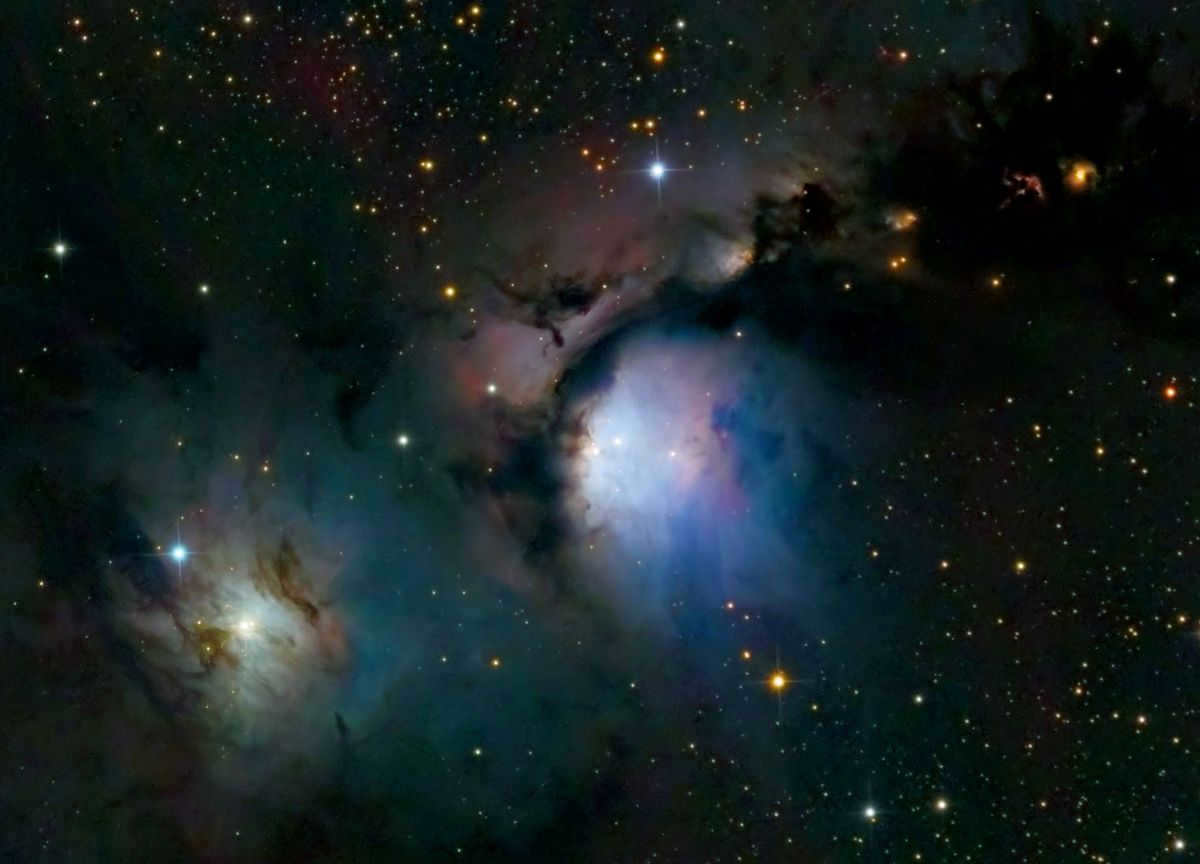
The Nebula of the Horsehead
This nebula, known as IC 434 or Barnard 33, is comprised of clouds of dust and gas that create a striking resemblance to the shape of a horse’s head. It is a part of the larger and brighter nebula, IC 434. Renowned for its brightness, the Horsehead Nebula frequently appears in various astronomical sources.
Located below and near Alnitak, the first star in Orion’s belt, this nebula was first discovered by American astronomer William Fleming in 1888. It is situated at a distance of 1,500 light years.
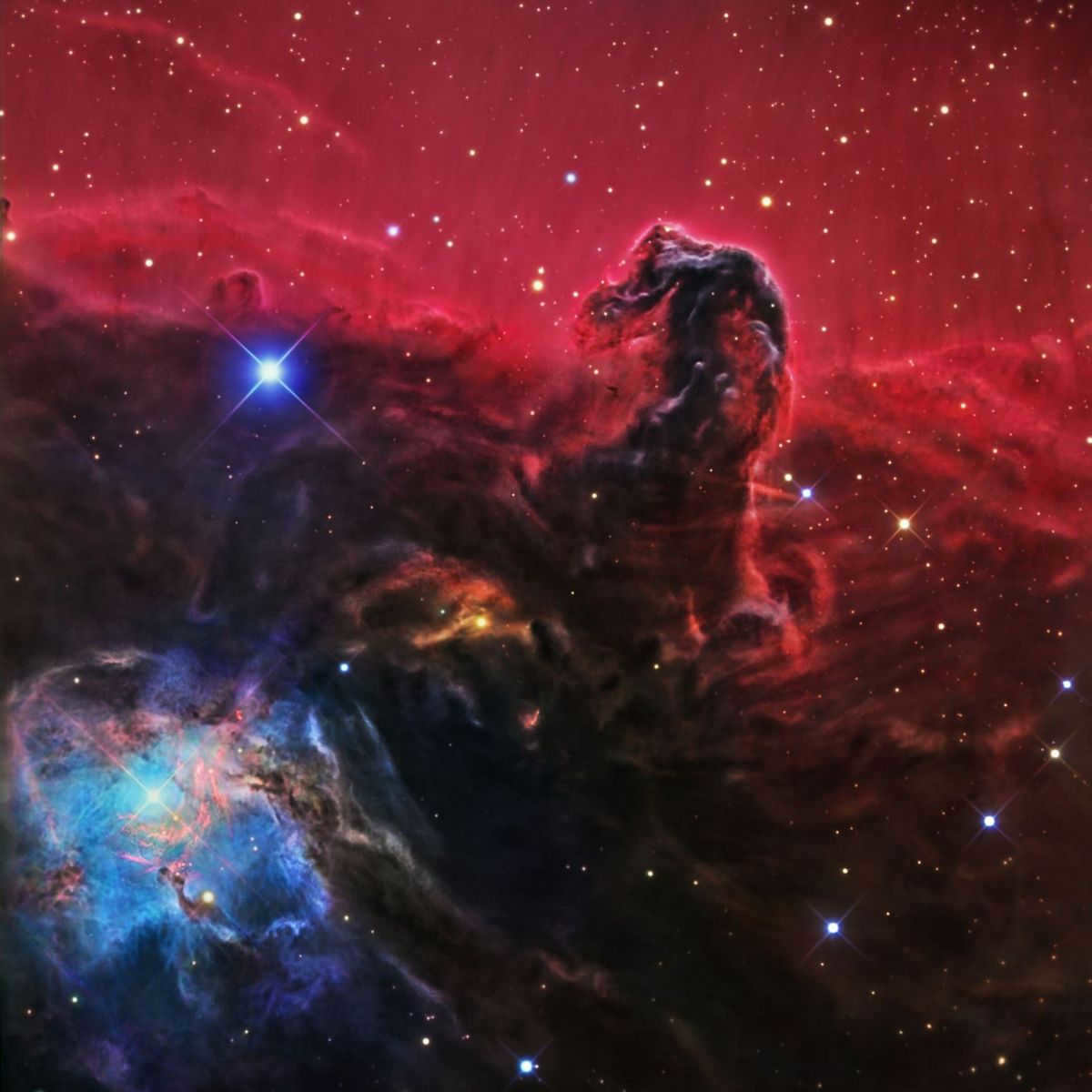
The nebula known as the Horsehead is a nebula composed of dark, dusty gas.
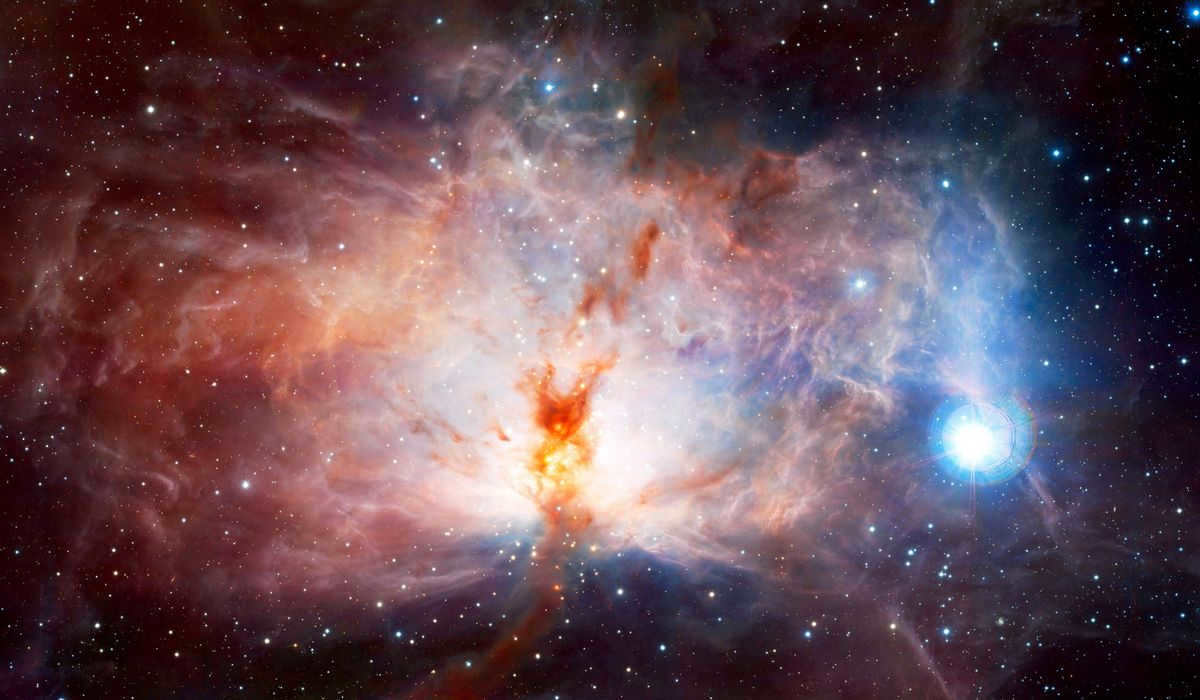
There are numerous other nebulae located within the constellation of Orion, primarily grouped near the Great Orion Nebula and the stars of Orion’s belt. All of these nebulae can be easily located using the Stellarium planetarium program. These nebulae are currently undergoing the process of star formation, resulting in the Orion constellation having the highest concentration of young, hot, and luminous stars, particularly giants, which will eventually undergo supernova events and give rise to new nebulae. This is evidenced by the presence of many unstable stars within each Orion nebula, similar to Taurus, whose internal structure is still being established and whose age does not exceed a few million years. These stars are in the early stages of their life cycle.
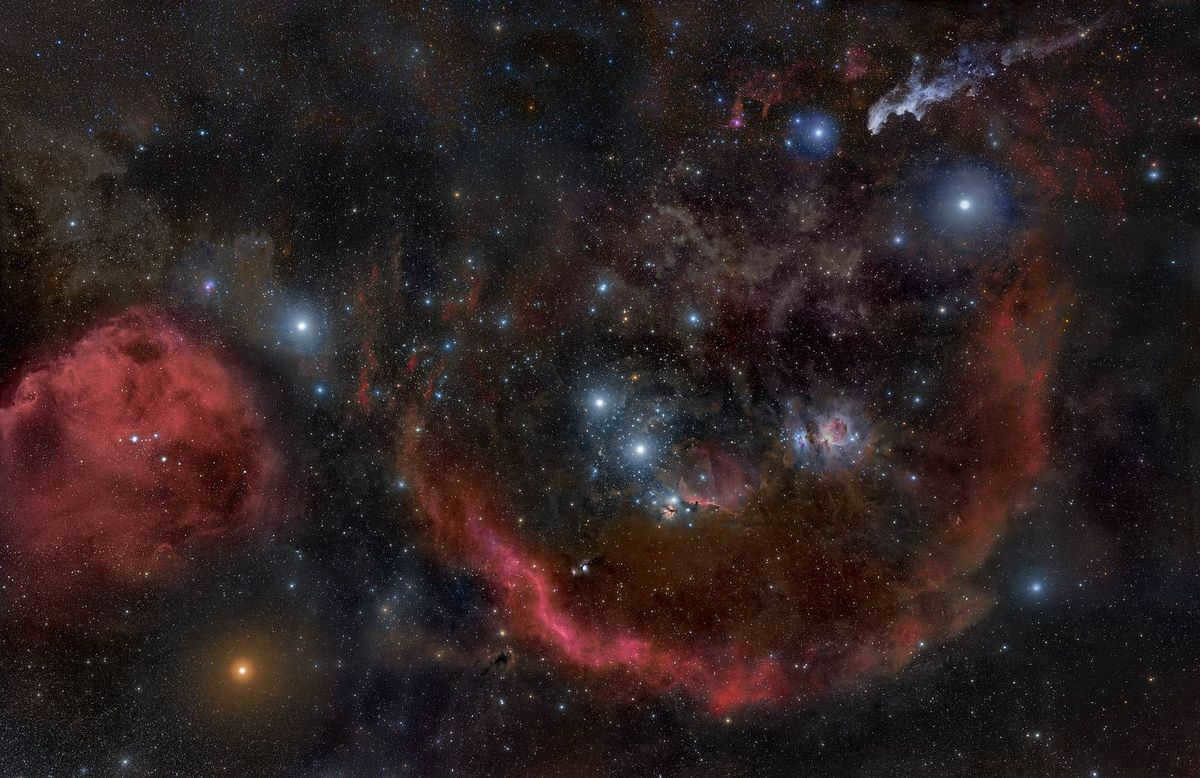
If you observe this constellation on a dark and clear night, you can effortlessly tally 200 stars. Within them are the entities that shape the outline of Orion. These consist of three extremely luminous stars with a stellar magnitude of zero. Five of the outline stars are of second magnitude, while four are of third magnitude. These stars encompass variables, nebulae, hot star associations, and asterisms. The two most brilliant stars in the Orion constellation are Rigel and Betelgeuse.
The Changing Appearance of the Orion Constellation Throughout the Year
The Orion constellation is typically associated with the winter season, making it visible from late autumn to spring in the northern hemisphere. It first emerges on the eastern horizon in mid-October during dusk, gradually revealing its full splendor as time goes on.
During winter, once darkness envelops the sky, the Orion constellation can be observed at a considerable height. Even the neighboring constellation, the Big Dog, featuring the brilliant Sirius star, becomes easily visible. The optimal period to witness this constellation at its highest point above the horizon is January.
As spring approaches, the Orion constellation gradually shifts towards the western sky, descending lower and lower. In mid-spring, Betelgeuse, one of the prominent stars in the constellation, can be spotted at its peak before ultimately disappearing from view.
During summer, the Orion constellation becomes invisible in the northern hemisphere, only appearing in the southern hemisphere during this time.
Observation
can be rephrased as
Noticing
,
Perception
, or
Examination
.
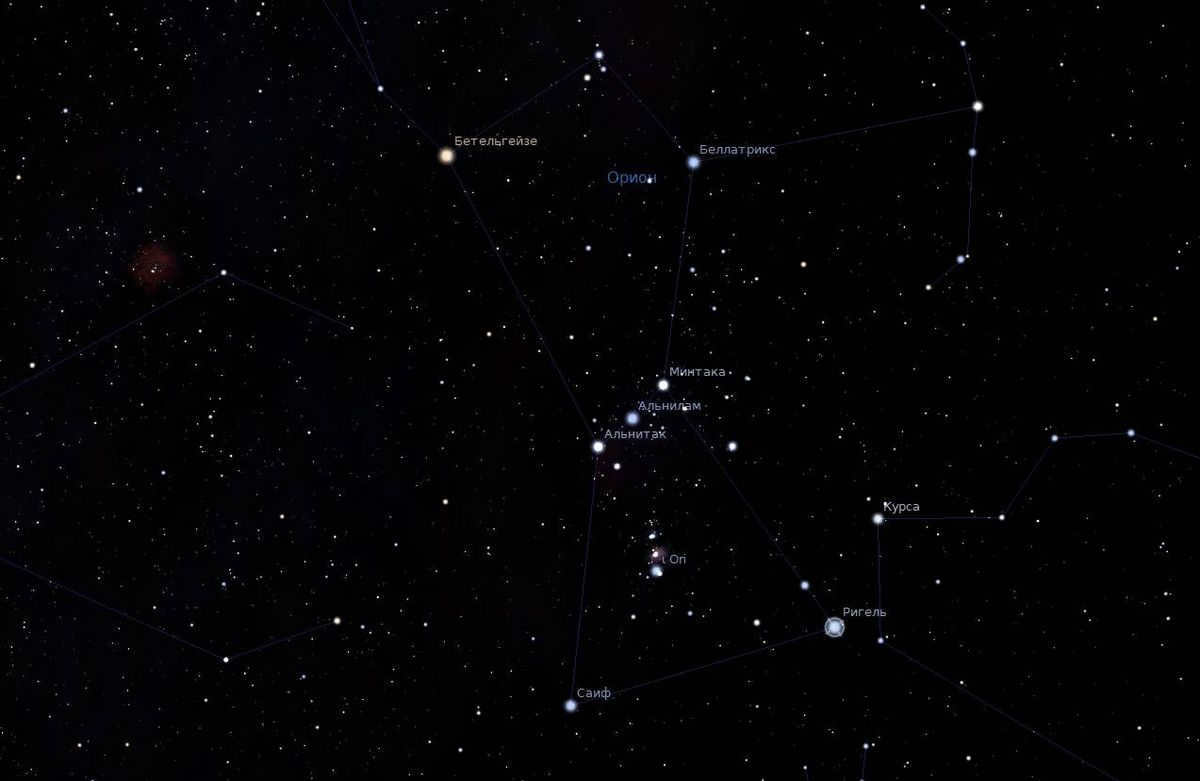
The constellation Orion is visible during the late summer, autumn, and winter seasons, and can be observed in Russia until mid-April. It is classified as a constellation of the autumn and winter skies.
As previously mentioned, the optimal time for observing the night sky in Russia is during the autumn and winter seasons. The visibility of the constellation we are discussing varies depending on the specific location and month of observation. The most favorable months for spotting this constellation are from November to January. During the month of November, Orion can be seen rising in the late evening.
In the vast expanse of the night sky, you will have no trouble identifying this renowned constellation. Its distinctive feature is a sequence of three bright stars known as Orion’s belt.
The upper left star, Betelgeuse, appears red in color, while the lower right star, Rigel, is white. Orion’s Belt is positioned at the center of this constellation.
Make sure to locate this constellation and witness its breathtaking beauty firsthand.

Top 17 biggest and most formidable nuclear power plants worldwide: list of nations, pictures
Orion is a prominent constellation situated on the celestial equator and visible globally. It stands out as one of the most easily recognizable constellations in the night sky. It derives its name from Orion, a hunter in Greek mythology. Its most prominent stars are the blue-white Rigel (Beta Orionis) and the red Betelgeuse (Alpha Orionis).
- 1 History and mythology
- 1.1 Ancient Near East.
- 1.2 Greco-Roman antiquity
- 1.3 Near East
- 1.4 Asian antiquity
- 1.5 European folklore
- 1.6 America
- 1.7 The Polynesians
- 1.8 Contemporary Symbolism
- 1.8.1 Depicted in Fiction
- 4.1 Shining stars
- 4.2 Constellation
- 4.3 Blade
- 4.4 Mind
- 4.5 Weapon
- 4.6 Protection
- 4.7 Falling stars
- 4.8 Celestial Objects
- 7.1 Explanatory Notes
- 7.2 References
- 7.3 Works Cited
History and Mythology
The oldest recorded representation connected with the constellation of Orion is an ancient (Orignacian) sculpture made from mammoth ivory discovered in a cave in the Ach Valley in West Germany in 1979. Experts approximate the age of this valley to be between 32,000 and 38,000 years old. Orion’s unique design is acknowledged in various societies across the globe, and there exist numerous legends linked to it. Orion serves as a emblem in contemporary society.
Ancient Near East
Orion (constellation) Art
The star catalogs of ancient Babylon during the Late Bronze Age referred to the constellation Orion as SIPA.ZI.AN.NA, which translates to “Heavenly Shepherd” or “True Shepherd of Anu.” Anu, the chief deity of the celestial realms, holds great significance in Babylonian mythology. Within this constellation, two minor gods named Papshukal and Ninshubur are revered as messengers of the gods. Papshukal is closely associated with the depiction of a walking bird on Babylonian boundary stones, while the figure of the Rooster is positioned below and behind the figure of the True Shepherd on the star chart. These constellations symbolize the messenger of the gods in both bird and human forms, respectively.
The Armenians associated their legendary patriarch and founder Hayk with the constellation Orion. In the Armenian translation of the Bible, Hayk is also referred to as Orion.
The Bible mentions Orion three times, using the term “Kesil” (כסיל, meaning “fool”). While this name may be linguistically connected to “kislev,” the ninth month of the Jewish calendar (November-December), which potentially derives from the Hebrew root KSL, meaning “hope” or “positive,” as in the words “kesel, kisla” (כֵּסֶל, כִּסְלָה, hope for winter rains). The references to Orion in the Bible can be found in Job 9:9 (“He created the Bear and Orion”), Job 38:31 (“Can you loosen Orion’s belt?”), and Amos 5:8 (“He who created the Pleiades and Orion”).
In ancient Aram, the constellation was known as Nfilah, and the Nephilim were believed to be descendants of Orion.
Ancient Times of Greece and Rome
In Greek mythology, there was a legendary figure named Orion who was a colossal and extraordinarily powerful hunter. He was born to Euryale, a Gorgon, and Poseidon, the god of the sea. According to one myth, Orion provoked the wrath of Gaia, the goddess of the Earth, by boasting that he could exterminate every animal on the planet. In her fury, Gaia attempted to eliminate Orion with the aid of a scorpion. This encounter is significant because the constellations of Scorpio and Orion are never simultaneously visible in the sky. However, Orion was ultimately revived by the Serpent Goddess, known as the Serpentine, who provided him with an antidote. This event is believed to be the reason why the constellation of Serpentor is positioned midway between Scorpio and the Hunter in the night sky.
References to the constellation of Orion can be found in various works of literature, including Horace’s Ode (Ode 3.27.18), Homer’s Odyssey (Book 5, line 283) and Iliad, as well as Virgil’s Aeneid (Book 1, line 535).
Middle East
In the medieval era of Islamic astronomy, Orion held the name of al-Jabbar, which translates to “the giant”. Saif, the sixth brightest star in Orion, derives its name from the Arabic phrase saif al-jabbar, meaning “sword of the giant”.
Asian ancient times
In ancient China, Orion was recognized as one of the 28 lunar mansions of Xiyo (Xu) (宿). It was referred to as Shen (參), which directly translates to “three”, representing the three stars of Orion’s Belt. (Refer to Chinese constellations)
The Chinese character 參 (pinyin sheng) originally symbolized the constellation Orion (Chinese: 參 宿; pinyin: shēnxiù); its Shang dynasty version, dating back over three thousand years, features an image at the top depicting the three stars of Orion’s Belt on a person’s head (the bottom part represents the word sound, which was added later).
In the Rigveda, the constellation known as Orion is referred to as Mriga, which translates to “Deer”. The constellation is depicted as having two bright stars in front and two bright stars behind, representing hunting dogs. Positioned in front of the two front dogs is a comparatively less bright star, symbolizing the Hunter. In the center of all four hunting dogs, there are three bright stars. The Stag (Mriga) is represented by the three smaller aligned but less bright stars. In the local folk language, the Stag is known as Harnu, and there are numerous folk songs that tell the tale of Harnu. The Malay name for Orion’s Belt is Bintang Tiga Beradik, which translates to “Three Star Brothers”.
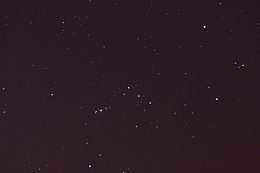
Orion, captured on camera in Kuantan, Malaysia
In India, there is a constellation named Orion, where Nataraja, the ‘cosmic dancer’ (an incarnation of Shiva), is often observed.
In the first century BC, a Jain symbol resembling Orion was carved in the caves of Udayagiri and Khandagiri, India.
The Bugis sailors recognized the three stars in Orion’s Belt as tanra tellu, which translates to “sign of three”.
Legends from Europe
In ancient Hungarian folklore, Orion is recognized as the mystical Archer (Íjász) or Reaper ( Kasász). In recently uncovered tales, he is referred to as Nimrod (Hungarian “Nimrod”), the greatest hunter and the father of the twins “Hunor” and “Magor”. The stars “π” and “o” (located at the top right) combine to form a reflective bow or a raised scythe. In other Hungarian legends, Orion’s “belt” is known as the “judge’s stick” (Bírópálca).
In the Scandinavian mythos, Orion’s “belt” is identified as Frigg the Spinner (Friggerok) or Freya’s Spinner.
In Siberian folklore, the Chukchi people view Orion as a hunter; the arrow he released is represented by Aldebaran (Alpha Taurus) with the same shape as other depictions in the Western world.
The Seri people of northwestern Mexico refer to the three stars in Orion’s belt as Hapj, a term that signifies a hunter. These stars are comprised of Hap, which represents a mule deer, Haamoja, which symbolizes a wilorog, and Modjet, which represents a snow sheep. Hap, located in the middle, was targeted by a hunter and as a result, his blood dripped onto the island of Tiburon.
These same three stars are recognized in Spain and across much of Latin America as “Las tres Marías” or “The Three Marys”. In Puerto Rico, they are referred to as “Los Tres Reyes Magos” or “The Three Wise Men”.
The Ojibwa (Chippewa) Native Americans have named this constellation Cabibona’can, which translates to the Creator of Winter, as its presence in the night sky signals the arrival of winter.
The Lakota Native Americans believe that Tayyamnikanhu, also known as Orion’s Belt, is the backbone of a buffalo. The large rectangle of stars in Orion represents the buffalo’s ribs, while the Pleiades star cluster in the neighboring Taurus constellation is seen as the buffalo’s head. Sirius, found in the constellation Canis Major, is known as Taiyamnicinte and is considered the buffalo’s tail. In another Lakota myth, the lower half of Orion, known as the Constellation of the Hand, symbolizes the hand of a chief who was punished by the gods for his selfishness by being robbed by the Thunder Nation. The chief’s daughter offers to marry anyone who can lift her father’s hand from the sky, and a young warrior named Fallen Star, whose father was a star and mother was a man, returns the hand and marries the chief’s daughter, representing harmony between the gods and humans with the help of the younger generation. In this myth, Rigel represents the index finger, the Orion Nebula represents the thumb, Orion’s Belt represents the wrist, and the Beta Eridani star represents the little finger.
Polynesian
The constellation Heiheionakeiki, which represents a child’s rope-like cat’s cradle, is made up of the seven main stars of Orion in Polynesian culture.
Modern symbolism
The belt and sword imagery of Orion has been incorporated into popular Western culture. For example, the shoulder badges of the 27th Infantry Division of the United States Army during both World Wars were shaped like the constellation’s belt and sword. This may be due to a pun in the name of the division’s first commander, Major General John F. O’Ryan.
Orion Pictures, a movie company, adopted the constellation as its logo.
In the realm of literature.
Within J. R. R. R. Tolkien’s intricate mythology surrounding Middle-earth, Orion is famously referred to as Menelvagor, a title that translates to “Heavenly Swordsman” in the elven language of Sindarin.
In the iconic film Blade Runner, the dying replicant known as Roy Batty poetically reflects upon his experiences in a monologue titled “Tears in the Rain”: “I have witnessed sights beyond comprehension. Attack ships ablaze, cascading from Orion’s celestial shoulder. I have beheld the radiant shimmer of C-rays amidst the obscurity near the gates of Tannhäuser. All of these profound moments shall inevitably fade away, akin to droplets dissolving within the downpour. The time for my demise has arrived.”
In the Haven TV series, the Hunter meteor shower is recognized as the Orionid meteor shower. It visits Haven once every twenty-seven years, coinciding with the arrival of the Barn, which serves as a gateway between two realms, and the abduction of an enigmatic woman. As the Barn departs, the Hunter gracefully traverses the sky, bringing an end to the Troubles and transforming the town of Haven into a sanctuary for the Restless.
Visuals
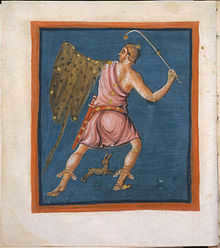
Orion is depicted in the 9th century Leiden Aratea, a manuscript that features various artistic representations of constellations.
One common motif in these depictions is Orion’s association with the surrounding constellations. He is often shown standing near the river Eridanus, accompanied by his two hunting dogs, Canis Major and Canis Minor. In some illustrations, Orion is engaged in a battle with the constellation Taurus. Other times, he is shown hunting the constellation Lepus, symbolizing his pursuit of the hare. Additionally, there are depictions of Orion holding a lion skin as a symbol of his strength and prowess.
There are various ways to depict Orion. Orion appears differently when viewed from the Southern Hemisphere, as it is oriented with the south side facing upwards. In Australia and New Zealand, the belt and sword of Orion are often referred to as the pot or pot. In South Africa, particularly among Afrikaans speakers, Orion’s belt is called Drie Konings (Three Kings) or Drie Susters (Three Sisters). Similarly, in 17th and 18th century Dutch star charts and sailors’ guides, the name Driekoningen (Three Kings) is frequently used to describe the same three stars. In Spain, Latin America, and the Philippines, these three stars are known as “Las Tres Marías” (The Three Marys) or simply as “Los Tres” (The Three). In Puerto Rico, they are referred to as “Los Tres Reyes Magos” (The Three Wise Men).
There were significant variations in the traditional portrayals of Orion. Cicero depicted Orion in a manner that resembles the modern depiction. In his right hand, the Hunter held the hide of an unknown animal; Omicron Orionis represented his hand, while Pi Orionis represented the stars on the hide. Kappa and Beta Orionis represented his left and right knees, and Eta and Lambda Leporis represented his left and right feet, respectively. Similar to the modern depiction, Delta, Epsilon, and Zeta represented his belt. Alpha Orion represented his left shoulder, and Mu Orionis represented his left arm. His head was represented by Lambda Orionis, and his right shoulder was represented by Gamma. Hyginus’ portrayal was similar to Cicero’s, but there were some notable differences. Hyginus replaced the animal skin with a shield (Omicron and Pi Orionis), and instead of the hand represented by Mu Orionis, Orion held a club (Hi Orionis). Theta Orionis represented his right leg, and Lambda, Mu, and Epsilon Leporis represented his left leg. Subsequent depictions in Western Europe and Arabic countries followed these two models.
Distinctive Features
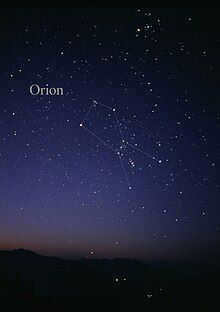
The constellation Orion is visible to the naked eye. The lines have been drawn.
Orion is surrounded by Taurus in the northwest, Eridanus in the southwest, Lepus in the south, Unicorn in the east, and Gemini in the northeast. Orion covers an area of 594 square degrees, making it the twenty-sixth largest constellation out of the 88. The boundaries of the constellation were established by Belgian astronomer Eugène Delporte in 1930 and are defined by a polygon with 26 sides. In the equatorial coordinate system, the right ascension coordinates of these boundaries range from 04 43.3 to 06 25.5, while the declination coordinates range from 22.87° to -10.97°. The three-letter abbreviation for Orion, as adopted by the International Astronomical Union in 1922, is “Ori”.
Orion can be easily seen in the night sky during the months of January to March, which corresponds to winter in the Northern Hemisphere and summer in the Southern Hemisphere. For those living in the tropics, where the distance from the equator is less than 8°, the constellation reaches its highest point directly overhead.
During the period between May and July, which is summer in the Northern Hemisphere and winter in the Southern Hemisphere, Orion cannot be seen in the daytime sky and is not visible at most latitudes. However, in most parts of Antarctica during the winter months of the Southern Hemisphere, the Sun remains below the horizon even at noon. As a result, the stars, including Orion, can be observed at dusk for a few hours around local noon, appearing low in the north. At the South Pole itself, specifically at the Amundsen-Scott South Polar Station, Rigel is only 8° above the horizon and the Belt of Orion stretches right along it. On the other hand, during the summer months of the southern hemisphere, when Orion is typically visible in the night sky, the constellation cannot be seen in Antarctica because the sun does not set south of the Arctic Circle during this time of year.
Navigational assistance
Utilizing Orion for locating stars in nearby constellations
Orion proves to be highly advantageous for identifying other stars. By extending the Belt towards the southeast, you can find Sirius (α CMa); to the northwest, Aldebaran (α Tau). Drawing a line across the two shoulders towards the east points you in the direction of Procyon (α CMi). Connecting Rigel to Betelgeuse reveals Castor and Pollux (α Gem and β Gem). Additionally, Rigel is a part of the Winter Circle asterism. Sirius and Procyon, which can be located from Orion using imaginary lines (refer to Map), are also key points in both the Winter Triangle and the Circle.
Distinctive Features
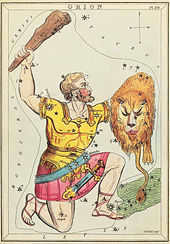
The constellation of Orion is depicted in the Mirror of Urania, a collection of maps of constellations that was published in London around 1825.
In the night sky, Orion’s seven brightest stars create a distinct hourglass-shaped formation. Four stars – Rigel, Betelgeuse, Bellatrix, and Cyphus – come together to form a large approximately rectangular shape. At the center of this shape are the three stars that make up Orion’s Belt – Alnitak, Alnilam, and Mintaka. Descending from the “belt” is a smaller line of three stars, known as the Sword of Orion (although the center star is not actually a star, but the Orion Nebula), also referred to as the Hunter’s Sword.
Many of these stars are luminous hot blue supergiants, and the stars in the belt and sword make up the Orion OB1 Association. Betelgeuse, which stands out for its red color, may actually be a member of the same group that has been propelled away from it.
Shining celestial bodies
- Betelgeuse, also known as Alpha Orion, is a colossal star of the M-type red supergiant variety that is approaching the final stages of its existence. Found in the constellation of Orion, it is the second most luminous star and exhibits irregular variations in brightness. It assumes the role of the “right shoulder” in the depiction of the hunter (when facing the observer). Historically, it has consistently ranked as the eleventh most brilliant star in the night sky, although its ranking fluctuated between the tenth and twenty-third positions in 2019. Scientists anticipate that Betelgeuse will undergo a supernova explosion as it nears the end of its life, which will be an awe-inspiring spectacle visible even during daylight. This celestial event is projected to occur within the next 100,000 years and will likely outshine both the Moon and Earth itself.
- Rigel, also identified as Beta Orion, is a luminous blue B-type supergiant that holds the position as the sixth most radiant star in the nocturnal heavens. Similar to Betelgeuse, Rigel undergoes the fusion of dense elements within its central region and will eventually transition from the supergiant phase (in terms of cosmic time) by either experiencing a catastrophic supernova or shedding its outer layers and transforming into a compact white dwarf. This celestial body plays the role of the left leg in the constellation Orion, symbolizing the mighty hunter.
- Bellatrix, which is known as Gamma Orionis according to Johann Bayer, holds the position of being the twenty-seventh most brilliant star in the night sky. Bellatrix is classified as a B-type blue giant, despite its insufficient size to undergo a supernova explosion. The luminosity of Bellatrix is attributed to its high temperature rather than its expansive radius. Serving as a marker for Orion’s left shoulder, Bellatrix conveys the meaning of a “warrior woman” and is sometimes informally referred to as the “Star of the Amazon.” Remarkably, it stands as the nearest large star to Orion, positioned at a mere distance of 244.6 light-years.
- Alnilam, also known as Epsilon Orionis, gets its name from the Arabic phrase that translates to “thread of pearls”. Situated in the middle of Orion’s Belt, it shines the brightest among the three stars. Alnilam is classified as a B-type blue supergiant and, despite being nearly twice as distant from the Sun as the other two stars, its luminosity makes it nearly equal in magnitude. Due to its size, Alnilam is experiencing a significant loss of mass. It is also noteworthy that Alnilam is the farthest large star in Orion, located at a distance of only 1,344 light-years.
- Alnitak, or Zeta Orion as it is designated, derives its name from the word meaning “belt” and represents the easternmost star in Orion’s Belt. This star system consists of three stars, with the main star being a hot blue supergiant and the brightest O-class star visible in the night sky.
- Cyphus, also known as Orion’s Kappa according to Bayer’s designation, is located at the right foot of Orion. It is situated at the same distance and size as Rigel, however, it appears significantly fainter. This gives it the nickname “sword of the giant.”
- Meissa, which is designated as Lambda Orion, forms the head of Orion and is a multiple star with a combined apparent magnitude of 3.33. Its name, “radiant,” reflects its brightness.
| Betelgeuse | Alpha Orionis | 624 | 0.42 |
| Rigel | Beta Orionis | 772 | 0.18 |
| Bellatrix | Gamma Orionis | 245 | 1.64 |
| Mintaka | Delta Orionis | 916 | 2.20 |
| Alnilam | Epsilon Orionis | 1,342 | 1.69 |
| Alnitak | Zeta Orionis | 800 | 1.88 |
| Saiph | Kappa Orionis | 650 | 2.07 |
| Meissa | Lambda Orionis | 1,042 | 3.47 |
Orion’s Belt
Orion’s Belt, also known as the Belt of Orion, is a well-known group of stars in the constellation. It is made up of three prominent stars: Zeta (Alnitak), Epsilon (Alnilam), and Delta (Mintaka). Alnitak is located approximately 800 light years away from Earth and shines with a brightness that is 100,000 times greater than that of the Sun. Most of its radiation falls in the ultraviolet range, making it invisible to the human eye. Alnilam, on the other hand, is about 1,340 light years away and has a magnitude of 1.70. It is an incredibly bright star, emitting 375,000 times more ultraviolet light than the Sun. Mintaka, which is situated 915 light years from Earth, has a stellar magnitude of 2.21 and is 90,000 times brighter than our Sun. It is also a binary star system, with the two stars orbiting each other every 5.73 days. In the Northern Hemisphere, Orion’s Belt is most easily visible in the night sky during the month of January, around 9:00 p.m., when it is near the local meridian.
To the southwest of Orion’s Sigma, there is a multiple star system called Eta Orionis, which consists of four stars and has a total apparent magnitude of 3.7. It is located 1,150 light-years away. Moving on to Mintaka, it is southwest of Alnitak and is part of a triple star system. The three stars form a small triangle that marks the head of Orion. Meissa, a hot blue giant with a spectral type of O8 III and an apparent magnitude of 3.54, is located at the apex of the triangle. It is approximately 1,100 light-years away. The base of the triangle is made up of Phi-1 and Phi-2 Orionis. Nearby, there is also a very young star called FU Orionis.
The Sword
The Head
Orion’s Club
The stars that form Orion’s club extend to the north of Betelgeuse. The elbow is marked by Mu Orionis, while the handle of the mace is marked by Nu and Xi. The end of the club is marked by Chi and Chi. East of Chi lies the variable red giant, Mira U Orion.
Orion’s Shield
To the west of Bellatrix, there are six stars known as Orion’s Pi (π Ori, π Ori, π Ori, π Ori, π Ori, π Ori, π Ori, and π Ori). These stars come together to form Orion’s shield.
Meteor shower
Every year, the Orionid Meteor Shower (Orionids) reaches its highest activity around October 20th. Located near the boundary of the Gemini constellation, observers can expect to see up to 20 meteors per hour. The source of this meteor shower is Halley’s Comet.
Astronomical entities in the vastness of space
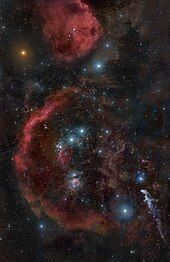
In this perspective, numerous less prominent features become apparent, including Barnard’s Loop.
M78 (NGC 2068) is an astronomical object located in the Orion constellation. With an overall magnitude of 8.0, it is not as bright as the well-known Great Orion Nebula in the southern region. However, M78 is approximately the same distance from Earth, at about 1,600 light-years away. When observed through a telescope, it can be mistaken for a comet due to its appearance. Additionally, M78 is linked to a variable star that exhibits rapid changes in brightness. Another prominent nebula in the Orion constellation is NGC 1999, which is also situated near the Great Orion Nebula. It has an integrated magnitude of 10.5 and is located 1,500 light-years away from Earth. NGC 1999 also hosts the variable star V380 within its structure.
Another notable nebula in the Orion constellation is IC 434, commonly known as the Horsehead Nebula. It is positioned near the star Zeta Orionis and contains a distinct dark dust cloud that resembles the shape of a horse’s head, giving the nebula its name.
NGC 2174 is an emission nebula situated at a distance of 6,400 light-years from Earth.
Aside from these nebulae, if you use a small telescope to explore Orion, you will discover numerous fascinating celestial objects in deep space, including M43, M78, and various stars like Iota Orion and Sigma Orion. With a larger telescope, you can observe entities such as Barnard’s Loop and the Flame Nebula (NGC 2024), as well as dimmer and denser multiple stars and nebulae.
All of these nebulae are components of the vast Orion molecular cloud complex, which is approximately 1500 light-years away and spans hundreds of light-years. It represents one of the most concentrated regions of star formation that is visible within our galaxy.
The future
An animation is displaying the movement of Orion from 50000 BCE to 50000 CE. P3 Orion is currently moving at the fastest speed.
Orion is positioned on the celestial equator, but its location will change over time due to the Earth’s axis precession. Orion is situated south of the ecliptic and is only on the celestial equator because the point on the ecliptic that corresponds to the June solstice is near the boundary between Gemini and Taurus, which is north of Orion. As precession continues, Orion will gradually move further south. By 14000 AD, Orion will be positioned far enough south to become invisible from the latitude of Great Britain.
Subsequently, the stars of Orion will slowly drift apart from the constellation due to their proper motion. Nevertheless, all of the most prominent stars in Orion are situated at a significant distance from Earth on a cosmic scale – much farther than Sirius, for instance. Orion will remain identifiable for a considerable period of time even as other constellations composed of relatively nearby stars undergo transformations and assume new configurations. There are, however, a couple of stars in Orion that will eventually go supernova and explode, such as Betelgeuse, which scientists predict will happen within the next one million years.
Related Links
- Astronomical portal
- Mythology Portal
- Eurion constellation
- Hubble 3D (2010), IMAX movie featuring a detailed computer-generated representation of the Orion Nebula
- Orion’s nebula in literature
- Orion’s correlation theory
- Orvandil
- Urania
- Winter Hexagon
Explanatory notes
Citations
Bibliography
- Levy, David H. (2005). Deep Sky objects. Prometheus Books. ISBN 1-59102-361-0 . CS1 maint: ref = harv (link )
- Ian Ridpath and Wil Tirion (2007). Stars and Planets Guide, Collins, London. ISBN 978-0-00-725120-9 . Princeton Universitl Press, Princeton. ISBN 978-0-691-13556-4 .
- Staal, Julius D.W. (1988), New patterns in the sky, McDonald and Woodward Publishing Company, ISBN 0-939923-04- 1
Links from other sources
| For more information on Orion, you can visit Wikimedia Commons. |
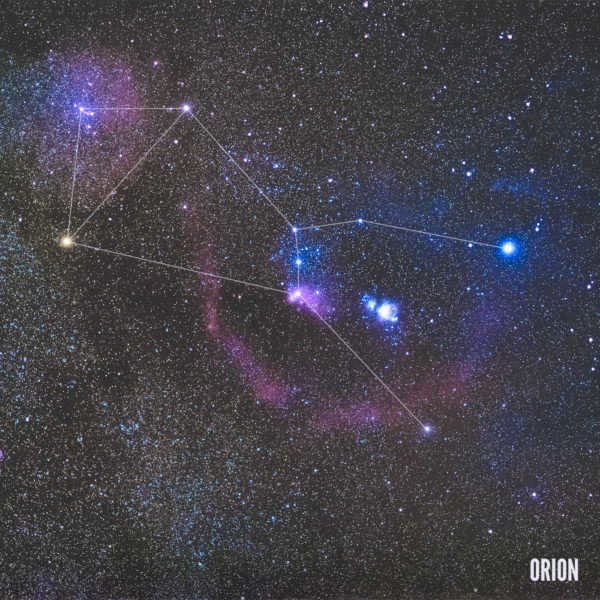
- Constellations
| Orion | |
| Latin name | Orion (gen. Orionis) |
| Brightest stars (magnitude < 3 m ) | Rigel (β Ori) – 0.18 m |
Betelgeuse (α Ori) – 0.2-1.2 m
Historical Background

According to Greek mythology, Orion, the great hunter, was considered a constellation in ancient Greece. He was believed to be the son of Poseidon and Euryale. After Orion was killed by the arrows of the goddess Artemis (or, according to another version of the myth, by the bite of Scorpio), his father Poseidon placed him in the sky as a constellation.
In ancient Russia, the constellation was known as Kruzhiliya or Kolo. In Armenia, it is referred to as Hayk, in honor of the patriarch and ancestor of the Armenians. According to traditional beliefs, Hayk’s soul ascended to the sky and became frozen, forming the constellation of Orion.
In the Inca Empire, the constellation known as Chakra was equivalent to Orion’s belt in the Chimu kingdom. The Chimu people referred to it as Pata, meaning “Captured”. It was believed that the moon dispatched the two outermost stars to apprehend the middle star, considering it a thief and criminal. These stars were then handed over to the “Vultures”, which are represented by the four stars located below and above in the constellation.
Orion, along with the Sun, Cassiopeia, Swan, Gemini, Pegasus, and Pleiades, is depicted on a ceramic vessel discovered near the Croatian town of Vinkovci (3000-2600 BC) from the Vuchedol culture.
The Legend of Orion the Hunter
In ancient mythology, the tale of Orion the Hunter has been passed down through generations. This legendary figure was known for his slender and agile physique, as well as his unparalleled hunting skills. Accompanied by his faithful companions, the Big Dog and the Little Dog, Orion would venture into the forests and mountains in search of wild animals.
Despite his formidable appearance, Orion possessed a kind and compassionate heart. One fateful day, as the Big Dog was chasing a hare, it cowered in fear and sought refuge at Orion’s feet. Ever the protector, Orion shielded the frightened creature from harm.
Equipped with a massive club and a razor-sharp sword, Orion found himself inexplicably drawn to the challenge of capturing elusive plaids. However, his pursuit was abruptly interrupted when an enraged bull charged towards him. Undeterred by the danger, Orion defiantly raised his right arm, brandishing his heavy club, and awaited the bull’s attack. With precision and strength, he struck the bull on the head, triumphantly overcoming the formidable beast.
Therefore, he journeyed across the majestic mountains and thick woodlands, in search of prey, until he eventually arrived at the captivating island of Chios where he met his untimely demise due to a venomous scorpion’s sting. However, news of Orion’s premature passing reached the ears of Aesculapus, who promptly embarked on a voyage to the island of Chios with the intent to resurrect him, just as he had done with countless others. This extraordinary act caught the attention of Hades, the formidable ruler of the underworld, who became increasingly concerned that Aesculapus was liberating the souls of the deceased. Hades voiced his grievances to his brother, Zeus the Thunderer, who responded by extinguishing Aesculapus’ life with a powerful bolt of lightning.
Description
Rephrase the text, making it unique and using the English language while preserving the HTML markup:
Description
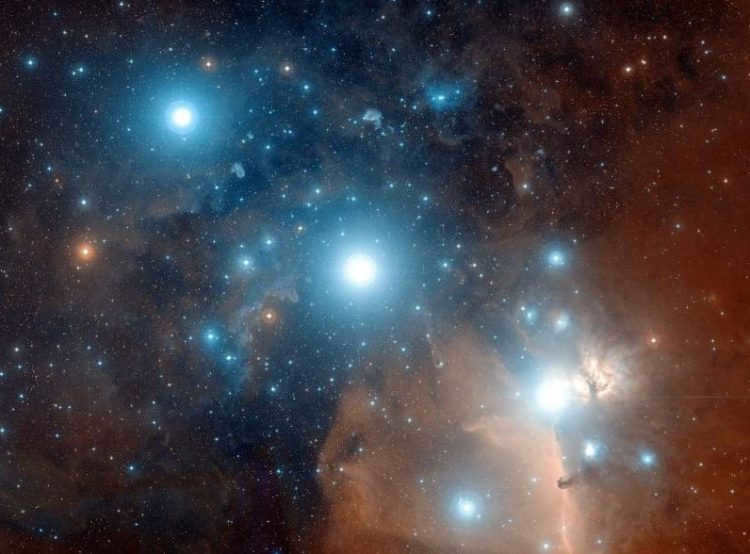
The Orion constellation is home to numerous hot stars belonging to the early spectral classes O and B, which come together to form a stellar association. Additionally, within the constellation of Orion, there are several orion variables. Among these are Taurus-type variables, which create three T-associations in Orion, as well as fuors, with Orion’s FU serving as the prototype.
Asterisms
An asterism is a group of stars that form a recognizable pattern in the night sky. They are smaller than constellations and often consist of stars from multiple constellations. Asterisms are popular among stargazers for their unique shapes and easy identification. Some well-known asterisms include the Big Dipper, the Summer Triangle, and the Teapot. These patterns have been recognized and named by various cultures throughout history. While not officially recognized by the International Astronomical Union, asterisms continue to be a popular way for people to navigate the night sky and appreciate its beauty.
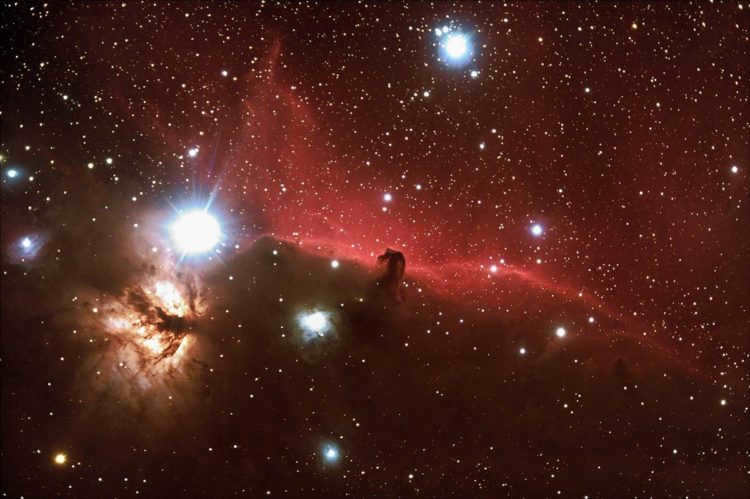
Asterism Sheaf, which defines the characteristic shape of the constellation, consists of the stars – α (Betelgeuse), β (Rigel), γ (Bellatrix), ζ (Alnitak), η (Mintaka), κ (Saif).
Another name for the asterism is Butterfly.
There are four asterisms that are associated with different parts of the traditional constellation figure:
- Orion’s Belt – the stars Mintaka, Alnilam, and Alnitak (Orion’s δ, ε, and ζ, respectively). It is also known as the Three Kings, the Three Magi (Magi), and the Rake.
- Sword of Orion – an asterism that includes two stars (θ and ι) and the Great Orion Nebula.
- Orion’s Shield – an asterism consisting of six stars arranged in an arc: π1, π2, π3, π4, π5, and π6. The ancient name for it is Turtle Shell.
- Orion’s club – a grouping of stars in the northern part of the constellation that consists of the five stars χ2, χ1, ν, ξ, and 69.
The following two groupings of stars actually share the same stars: Venus Mirror. The grouping of stars known as Orion’s Belt, which includes the star of the Sword’s hilt and the star η of Orion, forms a diamond-shaped mirror. The asterism Sword of Orion itself acts as the handle of the mirror. Therefore, this grouping of stars includes the stars η, δ, ε, ζ, θ, and ι of Orion.
A new asterism called the Saucepan Asterism has been discovered by astronomy enthusiasts in Australia. In the southern hemisphere of Earth, celestial objects, including constellations, appear in an inverted position compared to their visibility in the northern hemisphere. As a result, the Mirror of Venus asterism is seen inverted, with its handle serving as the handle of the Pot and the other stars forming the Pot itself. This asterism consists of the stars η, δ, ε, ζ, θ, and ι in the Orion constellation.
The primary celestial bodies in the Orion constellation are
Rigel
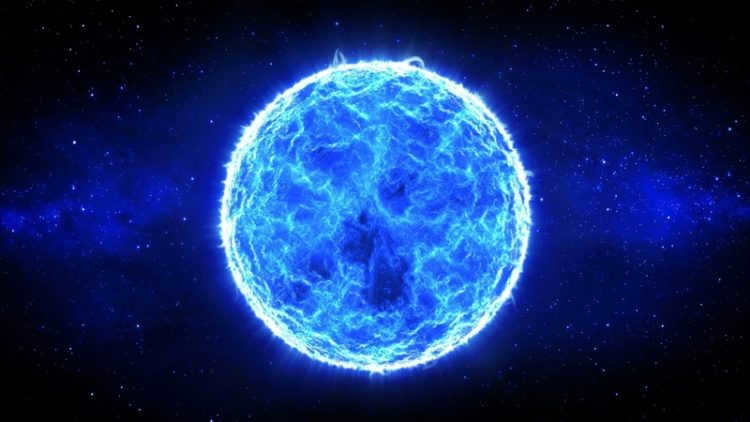
Rigel, also known as Beta Orionis, is a massive blue supergiant star located approximately 772.51 light-years away from Earth. It is much brighter than our Sun, with a luminosity that exceeds it by a factor of 85,000. Rigel has a mass equivalent to 17 times that of the Sun and is classified as a faint and irregular variable star. Its brightness varies between 0.03 and 0.3 magnitude over a period of 22 to 25 days.
With an apparent visual magnitude of 0.18, Rigel is the brightest star in the constellation Orion and the sixth brightest star in the night sky. It is actually a star system composed of three objects. In 1831, the astronomer F.G. Struve observed Rigel as a visual binary star surrounded by a gas shell.
Rigel A is an incredibly bright star, shining 500 times brighter than its companion Rigel B. Rigel B, in turn, is a spectroscopic double star with a magnitude of 6.7. This double star system consists of two main-sequence stars of spectral type B9V, and they orbit each other with a period of 9.8 days.
The star is surrounded by nearby dust clouds that it lights up. One of these clouds is IC 2118, also known as the Witch’s Head Nebula. It can be found 2.5 degrees northwest of Rigel in the constellation Eridanus.
IC 2118 is a part of the Taurus-Orion R1 association. Some scientists believe it would fit well in Orion’s OB1 Association, but it is too close to us. The star is approximately 10 million years old and will eventually evolve into a red supergiant resembling Betelgeuse.
The name Rigel comes from the Arabic phrase Riǧl Ǧawza al-Yusra, which means “left foot.” Rigel marks the left leg of Orion. In Arabic, it was also known as il al-Shabbar, meaning “the foot of the great one.”
Betelgeuse
Betelgeuse is a red supergiant star in the constellation of Orion. It is one of the largest known stars in the universe and is located approximately 640 light-years away from Earth. Betelgeuse is easily recognizable due to its reddish color and is one of the brightest stars in the night sky. It is also a variable star, meaning that its brightness can fluctuate over time. Betelgeuse is expected to go supernova in the next million years, and when it does, it will be visible from Earth even during the day. Despite its enormous size and status as a potential supernova, Betelgeuse is still a relatively young star, estimated to be only about 8 million years old.
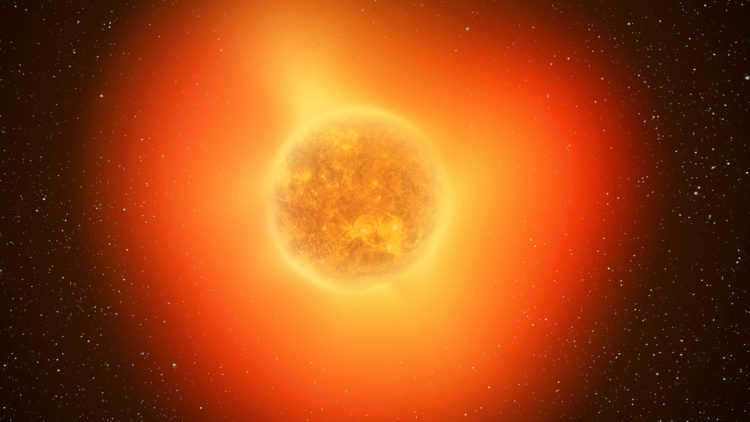
Betelgeuse, also known as Alpha Orionis or 58 Orionis, is a red supergiant star with a visual magnitude of 0.42, making it the second brightest star in the Orion constellation. It is located approximately 643 light-years away from Earth. The star’s absolute magnitude is -6.05.
Recent discoveries have revealed that Betelgeuse emits more light than 100,000 suns, surpassing the brightness of most stars in its class. This challenges the outdated classification of the star.
The apparent diameter of Betelgeuse ranges between 0.043 and 0.056 arc seconds. However, it is challenging to determine its exact size due to the star’s periodic changes in shape caused by its significant loss of mass.
It is a variable star of the semi-regular type, with its apparent visual magnitude ranging from 0.2 to 1.2 (sometimes surpassing the brightness of Rigel). It was initially observed by John Herschel in 1836. Despite being 10 million years old, it is not yet considered to be a red supergiant due to its relatively young age. However, it is believed to have undergone rapid evolution due to its immense mass. In the coming million years, it is expected to undergo a supernova explosion, during which it will be visible even during daylight hours (outshining the Moon and becoming the brightest supernova in history).
This star is part of two prominent asterisms in the night sky: the Winter Triangle (along with Sirius and Procyon) and the Winter Hexagon (consisting of Aldebaran, Capella, Pollux, Castor, Sirius, and Procyon).
Bellatrix
is a powerful and unique character.
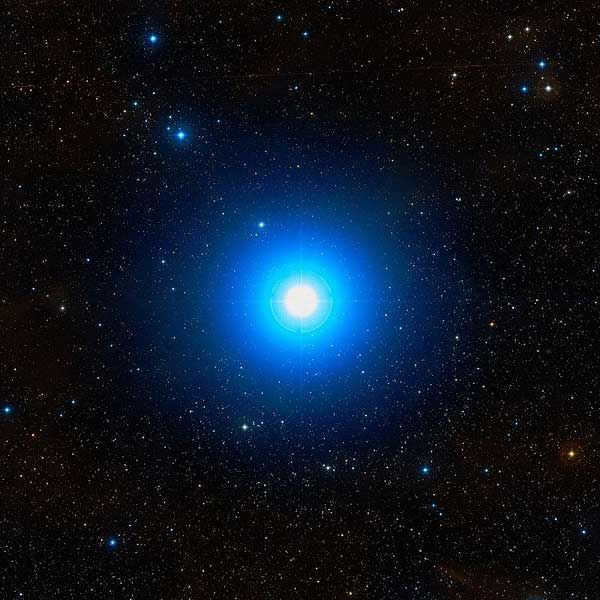
Bellatrix, also known as Orion Gamma or 24 Orion, is a massive blue-white giant star (B2 III) that shines brightly with an apparent magnitude that ranges from 1.59 to 1.64. Located approximately 240 light-years away, Bellatrix is one of the most scorching stars visible to the naked eye. It emits an incredible 6400 times more sunlight than our own Sun and possesses a mass that is 8-9 times greater. In the future, Bellatrix will evolve into an orange giant before eventually transforming into a massive white dwarf over the course of several million years.
Often referred to as the Amazon Star, Bellatrix holds the distinction of being the third brightest star in the Orion constellation and the 27th brightest in the entire sky. Its name is derived from the Latin term for “warrior woman.”
Mintaka
Mintaka, also known as Orion Delta, is a variable binary star system. The primary star in this system is a B-type giant, while the secondary star is a hot O-type star. These two stars orbit each other with a period of 5.63 days. During their orbit, they alternate in brightness, with each star outshining the other and causing a decrease in overall brightness by 0.2 magnitudes. Additionally, located 52″ away from the main stars, there is a third star with a magnitude of 7 and a faint fourth star with a magnitude of 14.
This star system is located approximately 900 light years away from Earth. The primary and secondary stars in Mintaka are incredibly bright, being 90000 times brighter than our Sun and having a combined mass that is more than 20 times that of the Sun. Interestingly, both of these stars are expected to end their lives with supernova explosions. When ranked by brightness, the apparent magnitudes of the stars in Mintaka are 2.23 (3.2/3.3), 6.85, and 14.0. The name “Mintaka” is derived from the Arabic word “manţaqah,” which means “region.” This star is the faintest star in Orion’s belt and the seventh brightest star in the constellation.
Alnilam
can be rephrased as “
The star Alnilam
“.
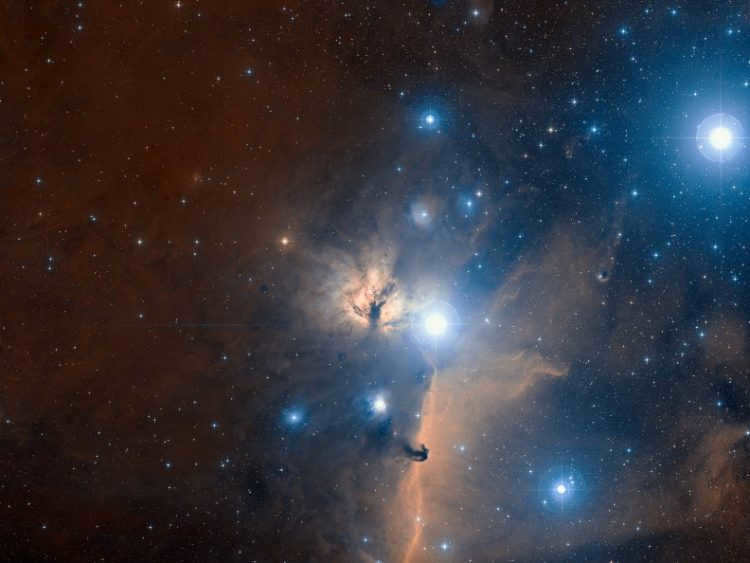
Alnilam (Orion Epsilon, 46 Orion) is a hot, bright blue supergiant (B0) with a visible magnitude of 1.70 and a distance of 1,300 light-years. It is the fourth brightest star in the constellation and the 30th brightest in the night sky. Alnilam is positioned at the center of the Orion’s belt. It emits a luminosity equivalent to 375,000 times that of the Sun.
This massive star is surrounded by the NGC 1990 nebula, which is a molecular cloud. The stellar wind generated by Alnilam reaches speeds of 2,000 kilometers per second. The star is approximately 4 million years old and is currently undergoing mass loss, indicating that its internal hydrogen fusion is approaching its end. In the near future, Alnilam will evolve into a red supergiant, surpassing the brightness of Betelgeuse, and eventually explode as a supernova. The name “Alnilam” is derived from the Arabic word “an-niżām,” which translates to “string of pearls.”
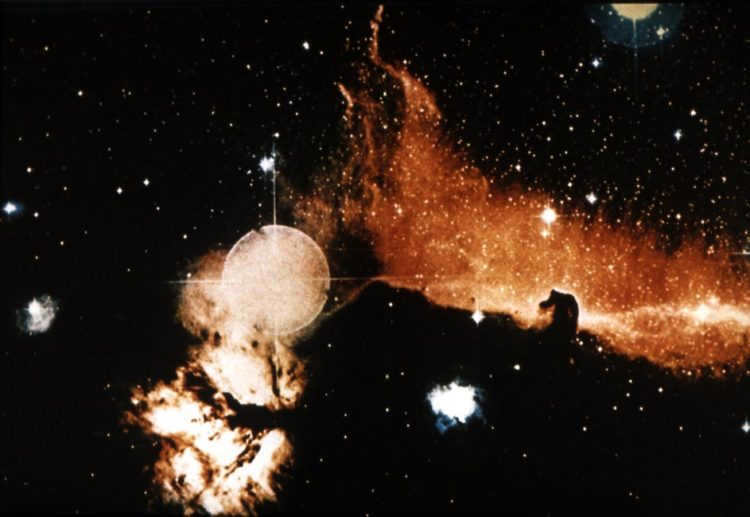
Alnitak (also known as Orion’s Zeta or 50 Orion) is a system of stars that can be seen from Earth with a magnitude of 1.72. It is located at a distance of 700 light-years. The brightest star in the system is Alnitak A, which is a hot and blue supergiant with a spectral type of O9. It has an absolute magnitude of -5.25 and a visual magnitude of 2.04.
Alnitak A is actually a close double star, consisting of a supergiant star with a spectral type of O9.7 and a mass 28 times that of the Sun. The second star is a blue dwarf with a spectral type of OV and an apparent magnitude of 4. This blue dwarf was discovered in 1998. The name Alnitak is derived from Arabic and means “belt”. This name is fitting as Alnitak is the easternmost star in the famous constellation Orion’s Belt. It is also located near the emission nebula IC 434.
Saif
can be paraphrased as
Saif is his name
.
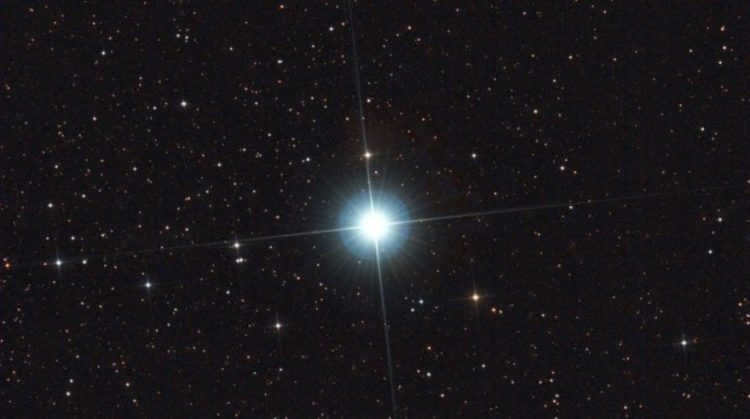
Orion’s Kappa Orion, also known as Saif or 53 Orion, is a blue supergiant star with a visual magnitude of 2.06 and located at a distance of 720 light-years. It is the 6th brightest star in the sky and can be found in the southeastern part of the Orion constellation.
The star gets its name from the Arabic phrase “saif al jabbar,” which means “sword of the giant.” Like many other luminous stars in Orion, Saif is expected to eventually undergo a supernova explosion.
Nair Al Saif
can be paraphrased as follows:
Nair Al Saif, an individual of great significance
.
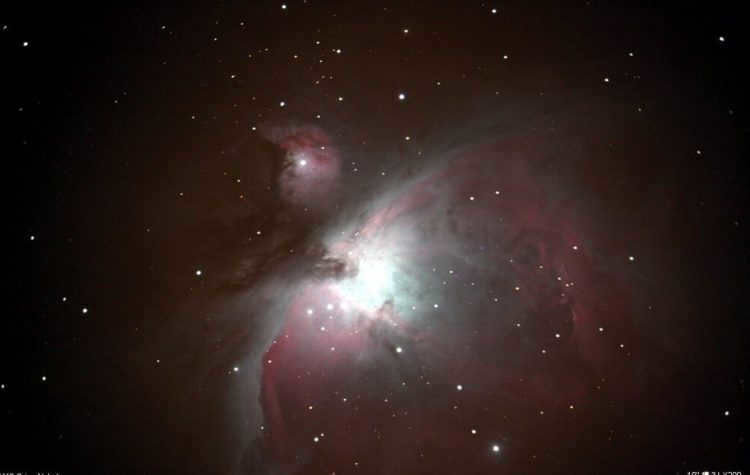
Nair Al Saif (Iota of Orion) is the brightest star in Orion’s sword and the fourth star system in the constellation. It has an apparent magnitude of 2.77 and is located approximately 1,300 light years away. The traditional Arabic name Na’ir al Saif translates to “bright sword.”
The primary component of the system is a massive spectroscopic double star with a 29-day orbital period. The system consists of a blue giant (O9 III) and a star (B1 III). Due to the constant collision of stellar winds between the two stars, Nair Al Saif is a significant source of X-ray radiation.
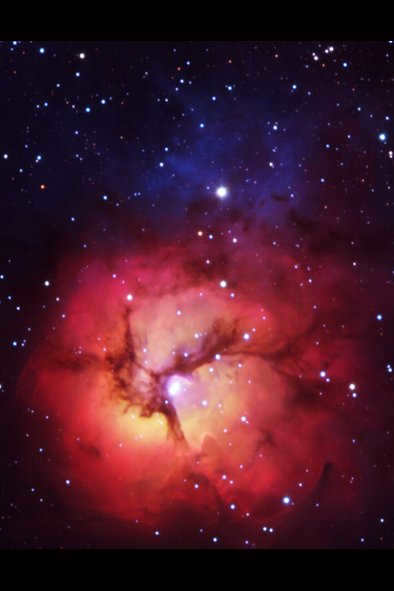
Orion’s Lambda is a massive star of the blue variety (O8III) with a visual magnitude of 3.39 and a distance of 1100 light years. It is a binary star system. The accompanying star is a small, hot blue-white dwarf (B0.5V) with a visible magnitude of 5.61. It can be found 4.4 arc seconds away from the main star.
The ancient Arabic name Meissa means “shining” and it is occasionally referred to as Heka, which translates to “white spot”.
Phi Orion
Phi Orion is the name given to a pair of star systems that are located 0.71 degrees apart. Phi 1, the first system, consists of two stars and is situated 1000 light years away. The main star in this system is a main-sequence star with a spectral class of B0 and an apparent magnitude of 4.39. On the other hand, Phi-2 is a giant star with a spectral class of K0 and an apparent visual magnitude of 4.09. It is located at a distance of 115 light years.
Orion’s Pi
Orion’s Pi represents a collection of stars that make up the protective barrier of the Orion constellation. Unlike the majority of binary and multiple star systems, the objects within this particular system are spread out over a significant distance. Pi-1 and Pi-6, for example, are separated by nearly 9 degrees.
- Pi-1 (7 Orion) is the least luminous star in this system. It is classified as a main-sequence white dwarf (A0) with an apparent magnitude of 4.60 and is located approximately 120 light-years away.
- Pi-2 (2 Orion) is a main-sequence dwarf (A1Vn) with an apparent magnitude of 4.35 and is situated approximately 194 light-years away.
- Pi 3 (1 Orion, Tabit) is a white dwarf (F6V) that resides 26.32 light-years from us. It holds the highest rank in brightness among all six stars in the system. With a mass of 1.2 times that of the Sun, a radius 1.3 times larger, and being three times brighter, it is also believed to potentially house planets similar in size to Earth. Al-Tabit, the star’s Arabic name, translates to “patience.”
- Pi-4 (3 Orion) is a binary star system located at a distance of 1,250 light-years. It consists of a giant star and a subgiant star, both of spectral type B2. These stars are so close to each other that they cannot be visually separated, even with a telescope. However, their spectra reveal their binary nature. The two stars orbit around each other with a period of 9.5191 days. They are 10 times more massive than the Sun and have luminosities that are 16,200 and 10,800 times brighter than the Sun.
- Pi-5 (8 Orion) is a single star located at a distance of 1,342 light-years. It has an apparent magnitude of 3.70.
- Pi 6 (10 Orion) is a bright orange giant star of spectral type K2II. It is a variable star with an average apparent magnitude of 4.45. It is located at a distance of 954 light-years.
Eta Orion
Eta Orion is a binary star system consisting of two blue stars (B0.5V). This system is located approximately 900 light-years away. Eta Orion is classified as a Beta Lyrae variable, meaning its brightness varies as one star eclipses the other. The visual magnitude of Eta Orion is 3.38. This star system can be found in the Orion arm, a minor spiral arm of our Milky Way galaxy. Specifically, it is situated to the west of Orion’s Belt.
Orion’s Sigma is a star system comprised of 5 stars situated to the south of Alnitak. The system is positioned at a distance of 1150 light-years.
The primary object is the binary star Sigma Orion AB, consisting of two hydrogen-fusing dwarf stars separated by 0.25 arc seconds. The brighter component is a blue star (O9V) with a visible magnitude of 4.2. The companion is a star (B0.5V) with a visible magnitude of 5.1. It takes them 170 years to complete one orbital revolution.
Sigma C is an A2V dwarf star with a visible magnitude of 8.79. Sigma D and E are B2V dwarf stars with magnitudes of 6.62 and 6.66. E is notable for its substantial helium content.
Orion’s V380
Rewrite the text, making it unique, using the English language and preserving the HTML markup:
Orion’s V380
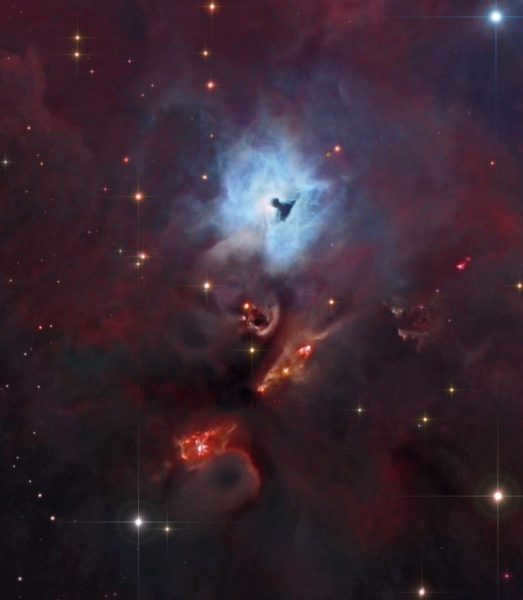
The V380 system in the Orion constellation is comprised of three stars and it is responsible for illuminating the reflected nebula NGC 1999. The spectral type of the V380 system is A0 and it is located approximately 1000 light years away.
Within the nebula, there is a large empty void that appears as a black spot in the central region. The cause of this darkness is currently unknown, but there are speculations that suggest narrow jets of gas from neighboring young stars may have penetrated the dust and gas layer of the nebula. Additionally, strong radiation emitted by an older star in the vicinity could have played a role in creating the hole. The nebula itself is situated at a distance of 1,500 light-years.
GJ 3379
GJ 3379 is a red dwarf star known as an M3.5V. It has a visual magnitude of 11.33 and is located 17.5 light years away from Earth. Interestingly, it is believed that GJ 3379 was actually much closer to our solar system in the past, about 4.3 light-years away, around 163,000 years ago. This makes it the closest star in the constellation of Orion to our own Sun. In fact, it is the closest star to us in the entire Orion constellation, which is home to many other fascinating celestial objects.
Celestial objects in Orion
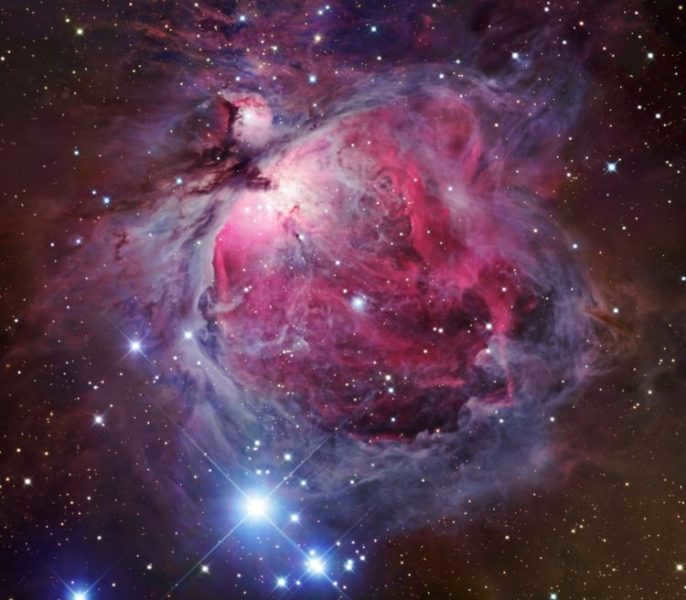
The German astronomer Johannes Zizat discovered the magnificent Orion Nebula in 1618. It is also known as Messier 42 (M 42) and can be found below Orion’s Belt. This luminous emission nebula has a greenish tint and appears as a smudged bright spot in binoculars.
The average density of this gaseous or diffuse nebula is 1017 times lower than that of room air. It is the most brilliant diffuse nebula and covers an area of approximately 80 x 60 angular minutes, which is more than four times the size of the full Moon. Its prominent location on the celestial equator allows it to be visible from nearly any location on Earth. The Orion Nebula is located about 1,600 light-years away from Earth and spans a diameter of 33 light-years.
The Orion Nebula emits a strong and vibrant light. However, this light is classified as “chilled” due to its predominantly luminescent nature, which is triggered by the presence of nearby hot stars in close proximity to the nebula or even within it.
Within the northern region of the nebula, a distinct dark strip of dust can be observed, separating its northeastern portion, known as M43, from the central body of the nebula.
M43 (Messier 43)
M43, also known as Messier 43, is a star-forming region located in the Orion Nebula. It is a small nebula that is part of a larger complex of interstellar clouds in the constellation of Orion. M43 is visible in the night sky as a distinct bright patch near the famous Orion’s Belt. It is believed to be a remnant of a supernova explosion that occurred millions of years ago.
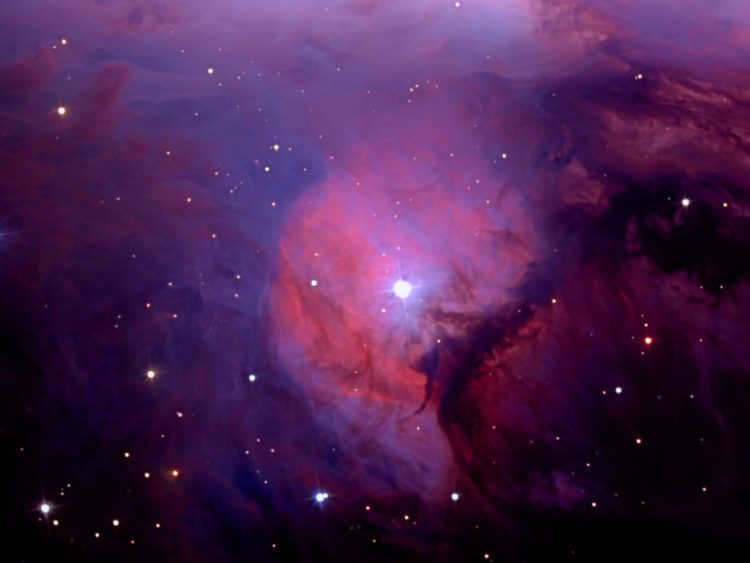
M43, also known as Messier 43, is an emission nebula located in the Orion constellation. This nebula is composed of ionized hydrogen and is a site of ongoing star formation. When observed through a telescope, M43 appears as a comma-shaped nebula positioned near the Orion Nebula.
In 1780, Pierre Messier discovered a group of highly reflective nebulae called M78 (Messier 78) in the Orion constellation. These nebulae are composed of three separate regions located to the northeast of ξ.
Located half a degree northeast of the Orion Nebula is another reflective nebula known as the Running Man (NGC 1977). The Running Man consists of both a nebula and a star cluster, creating a complex structure.
The Horsehead Nebula, located 0.5 degrees south of Orion’s ζ star in the Belt, is a well-known celestial object that stands out against the bright backdrop of the nebula. Discovered in 1888 through photographs taken by the Harvard Observatory, this nebula features dark dust clouds that resemble the shape of a horse’s head against a background of red glowing interstellar gas. The red glow is caused by the ionization of hydrogen gas behind the nebula, due to radiation from the nearby bright star ζ Orion. The darkness of the nebula’s background is primarily a result of light absorption by a dense layer of dust, although there are shaded areas to the left caused by the base of the Horsehead’s neck. The gas emitted by the nebula moves within a powerful magnetic field. At the base of the Horsehead Nebula, there are bright spots that indicate the presence of young stars in the process of formation. With a diameter of approximately 3.5 light-years, this nebula is part of the larger Orion Cloud.
Orion Cloud
Experience the power and flexibility of the Orion Cloud platform. With its advanced features and intuitive interface, Orion Cloud offers a seamless and efficient solution for all your cloud computing needs. Whether you’re a small business or a large enterprise, Orion Cloud can scale to meet your demands and deliver top-notch performance. Take advantage of our secure and reliable infrastructure to store, process, and analyze your data. With Orion Cloud, the possibilities are endless. Start harnessing the power of the cloud today!
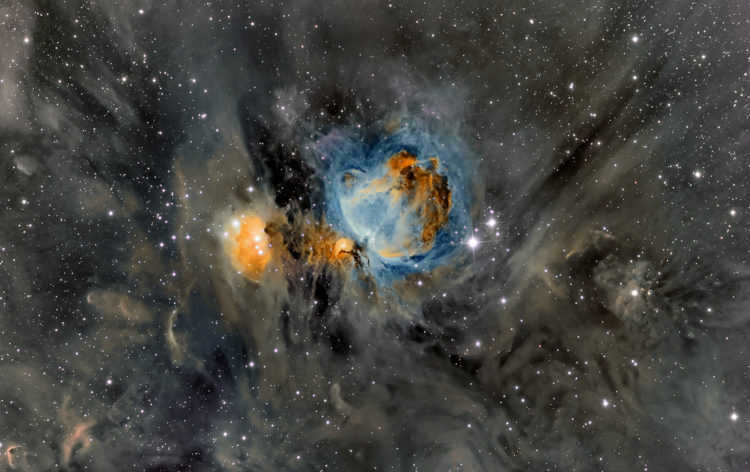
This is a collection of cosmic material (nebula) found in the Orion constellation. The Orion Cloud exists within the Milky Way galaxy, approximately 1600 light-years away, and spans a few hundred light-years in size.
The vast region occupied by the Orion cloud contains numerous known objects of various types that are made up of the material from this cloud. These objects can be observed using binoculars and amateur telescopes, such as the Orion Nebula (M42), M78, M43, Horsehead Nebula, Barnard’s Loop, Flame Nebula, the Running Man complex of reflective nebulae, and others.
- The Flame Nebula (officially designated NGC 2024) is an emission nebula located near the Horsehead Nebula.
- Barnard’s Loop covers a wide semicircle on its east-south side (and almost the entire constellation Orion). It is the remnants of a series of supernova explosions. The Orion molecular cloud is currently undergoing active star formation processes, with many young stars present. The most massive of these stars quickly progress through their life stages and eventually explode as supernovae, leaving their birthplace behind. Meanwhile, the young hot stars that have not yet reached their violent end continue to illuminate Barnard’s Loop.
- Another feature in the Orion constellation is the Italy Nebula (NGC 2024, Flame Nebula), which consists of both an emission nebula and a dark nebula.
Amateur stargazers are now able to contribute to scientific breakthroughs. As an illustration, on January 23, 2004, Jay McNeil, an astronomy enthusiast from Kentucky, directed his 3″ telescope towards the Orion constellation with the intention of capturing images of the M78 nebula. To his astonishment, upon analyzing the photograph, he observed a dazzling yet unfamiliar nebula. This nebula has since been designated as the McNeil Nebula. Positioned at the periphery of this nebula is a conspicuous star that provides illumination.
What is the method for locating the Orion constellation?
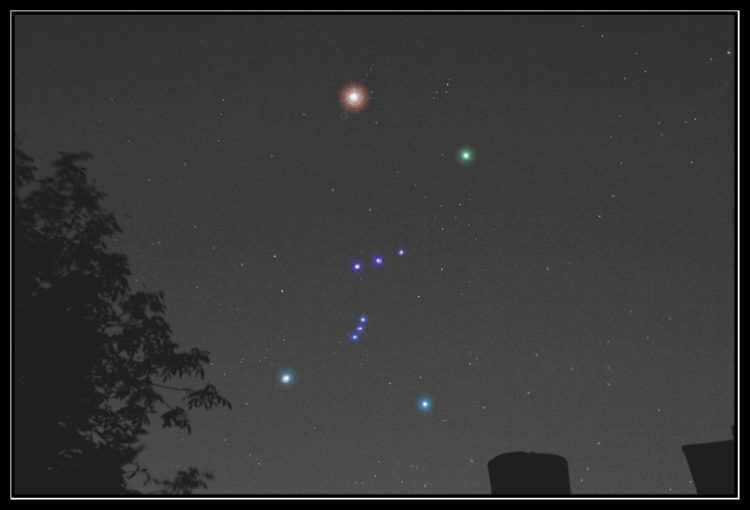
During late summer, fall, winter, and the first half of spring (up until mid-April), the constellation Orion is visible in the middle latitudes of the northern hemisphere. The best time for observations is between November and January when the constellation can be seen from sunrise to sunset. Orion can be observed throughout Russia and is classified as an autumn-winter constellation. In September, Orion rises in the early morning and remains visible for 2 hours before sunrise. In October, the constellation rises at night, and in November it rises in the late evening.
The Orion constellation is easily identifiable thanks to the arrangement of 7 luminous stars that form the torso of the hunter. Orion’s right shoulder is marked by the red supergiant Betelgeuse, while the dazzling white star Rigel is visible to the lower right. Situated between these bright stars is Orion’s Belt, which comprises three 2nd magnitude stars positioned equidistantly along a straight line.
If you mentally connect the stars of the belt and extend the line downwards, it leads to Sirius, the brightest star in the night sky and the principal star of the Canis Major constellation. In September, Sirius ascends in the southeast approximately 1.5 to 2 hours before sunrise. Due to its low position above the horizon, the star can twinkle and shimmer in a multitude of colors, resembling a precious gem illuminated by a ray of light.





